SB7
Session assets
Orals: Thu, 22 Sep, 17:30–18:30 | Room Andalucia 3
Introduction: Hayabusa2 spacecraft returned samples from near-Earth C-type asteroid 162173 Ryugu to the Earth on 6 Dec. 2020 [1]. Since the samples had been returned, we continue describing individual Ryugu particles for their images, weights, visible and infrared spectra with an optical microscope, a balance, a monochronic digital microscope with six-bands filters for incident light, an FT-IR and the infrared microscope MicrOmega [1, 2]. So far, 404 individual Ryugu particles have been handpicked and described for all or some of the methods [3-11].
Overview of initial descriptions of individual Ryugu particles: As mentioned in [3, 4], individual Ryugu particles have been grouped into angular or rounded in their shapes and smooth and rough in their mor-prologues. In total, those having rounded-shape (59%) and rough-surface (80%) are dominant in them. The relationship with their optical morphologies and surface mineralogizes were confirmed for the four individual Ryugu particles with an electron microscope [12], indicating those showing smooth surfaces showing space-weathering features on their surfaces. Although it is still poor in statistics, surface morphologies might reflect their mineralogical fea-ture such as space weathering. More samples should be investigated for better statistics to understand relationship between morphologies and space weathering. Among 404 individual Ryugu particles, 244 of them have been analyzed for their infrared reflectance spectra with the FT-IR. 2.7µm absorption, corresponding to presence of -OH, have been detected from all of them, indicating ubiquitous presence of hydrous minerals in Ryugu samples. 3.4 µm absorption features, corresponding to presence of carbonate and/or -CH, have been detected from 48% of them. As pointed before [3], this should be partially due to their heterogeneous distribution of carbonate and/or organic components in them, and that the spectral feature in 3.4 µm is much weaker than 2.7 µm so that it cannot be detected by the FT-IR. The MicrOmega will help to detect minor spectral features from such small particles, even though there is limitation of number of analyses per day (2 individual particles per day). Visible spectra of individual Ryugu samples have been also analyzed with the digital microscope of muti-band filters [7]. The average spectrum of 69 individual Ryugu particles are comparable to that of bulk Ryugu samples, indicating there is no spectrally different particle among them. Due to the schedule of analyses, not all of the individual Ryugu particles have been analyzed for the visible spectra, but we should proceed the analysis to understand overall spectral features of Ryugu samples.
Ryugu sample database and announcement of opportunity (AO) for Ryugu samples: All the obtained initial description data shown above is open in public by the Ryugu Sample Database System (https://darts.isas.jaxa.jp/curation/hayabusa2/) [13]. The first AO is ongoing based on this database, and the samples will be distributed to principal investigators of selected research proposals from this June (see detail in https://jaxa-ryugu-sample-ao.net/). Additionally, the second AO is planned to be released in this summer.
References: [1] Yada T. et al. (2021) Nature Astron. 6: 214. [2] Pilorget C. et al. (2021) Nature Astron. 6: 221. [3] Yada T. et al. (2022) LPS LIII, Abstract #1831. [4] Miyazaki A. et al. (2022) LPS LIII, Abstract #1816. [5] Hatakeda K. et al. (2022) LPS LIII, Abstract #1828. [6] Yogata K. et al. (2022) LPS LIII, Abstract #1767. [7] Yumoto K. et al. (2022) LPS LIII, Abstract #1326. [8] Yabe Y. et al. (2022) LPS LIII, Abstract #2371. [9] Pilorget C. et al. (2022) LPS LIII, Abstract #2088. [10] Carter J. et al. (2022) LPS LIII, Abstract #2017. [11] Loizeau D. et al. (2022) LPS LIII, Abstract #1495. [12] Nakato A. et al. (2022) LPS LIII, Abstract #1810. [13] Nishimura M. et al. (2022) LPS LIII, Abstract #1731.
How to cite: Yada, T., Abe, M., Yogata, K., Miyazaki, A., Hatakeda, K., Hitomi, Y., Sugiyama, Y., Nishimura, M., Sakamoto, K., Kanemaru, R., Kumagai, K., Soejima, H., Nakato, A., Okada, T., Fukai, R., Sugahara, H., Ishizaki, T., Suzuki, S., Tachibana, S., and Usui, T. and the ONC-T team and IAS team: Present status of initial descriptions and distributions of Ryugu samples returned by Hayabusa2, Europlanet Science Congress 2022, Granada, Spain, 18–23 Sep 2022, EPSC2022-1100, https://doi.org/10.5194/epsc2022-1100, 2022.
Introduction: On December 6, 2020, the Hayabusa2 mission successfully returned to Earth ~ 5.4 g of samples collected at the surface of the C-type asteroid Ryugu [1,2]. Its surface was first sampled on February 22, 2019 ("bulk A"), then on July 11, 2019, close to a 15-meter large artificial crater, so as to possibly access sub-surface material ("bulk C") [3]. The collected samples are now kept at the JAXA Extraterrestrial Curation Center in ISAS (Institute of Space and Astronautical Science) for a first round of preliminary analyses, with the objective of characterizing in a non-destructive manner both the bulk samples and a few hundreds of grains extracted from them [4]. In particular, the goals were 1) to support their further detailed characterization by the international Initial Analysis Teams, and 2) to build a catalogue of the grains, accessible to the international community through AO selection, starting mid-2022. Importantly, the analyzed samples have always been kept, since their collection, in a fully clean and controlled environment either under vacuum or ultra-clean N2. The analyses performed within the curation facility provided an unexpected set of important results.
Methods: The preliminary characterization of these samples is being conducted with a visible microscope equipped with six color filters [4], a FTIR spectrometer (1-4 µm) [4], and MicrOmega, a hyperspectral microscope [5], operating in the near-infrared range (0.99-3.65 µm) where diagnostic signatures of most candidate minerals and molecules of relevance (e.g. mafic minerals, altered phases, salts, ices, aliphatic/aromatic CH, NH-rich compounds) can be found. For each 22.5×22.5 µm2 pixel of the 250×256 pixels2 field of view, the reflectance spectrum is retrieved in up to 400 contiguous spectral channels. Both the negligible amount of illuminating power at less than 10-8 W/px and the lack of contact with the samples allow entirely non-destructive and non-invasive characterization. By the beginning of 2022, bulk samples from chamber A and chamber C of the Hayabusa2 returned capsule (each divided into 3 sub-bulks), as well as >200 individual grains and 14 “small-bulks” extracted from them have been analyzed with MicrOmega.
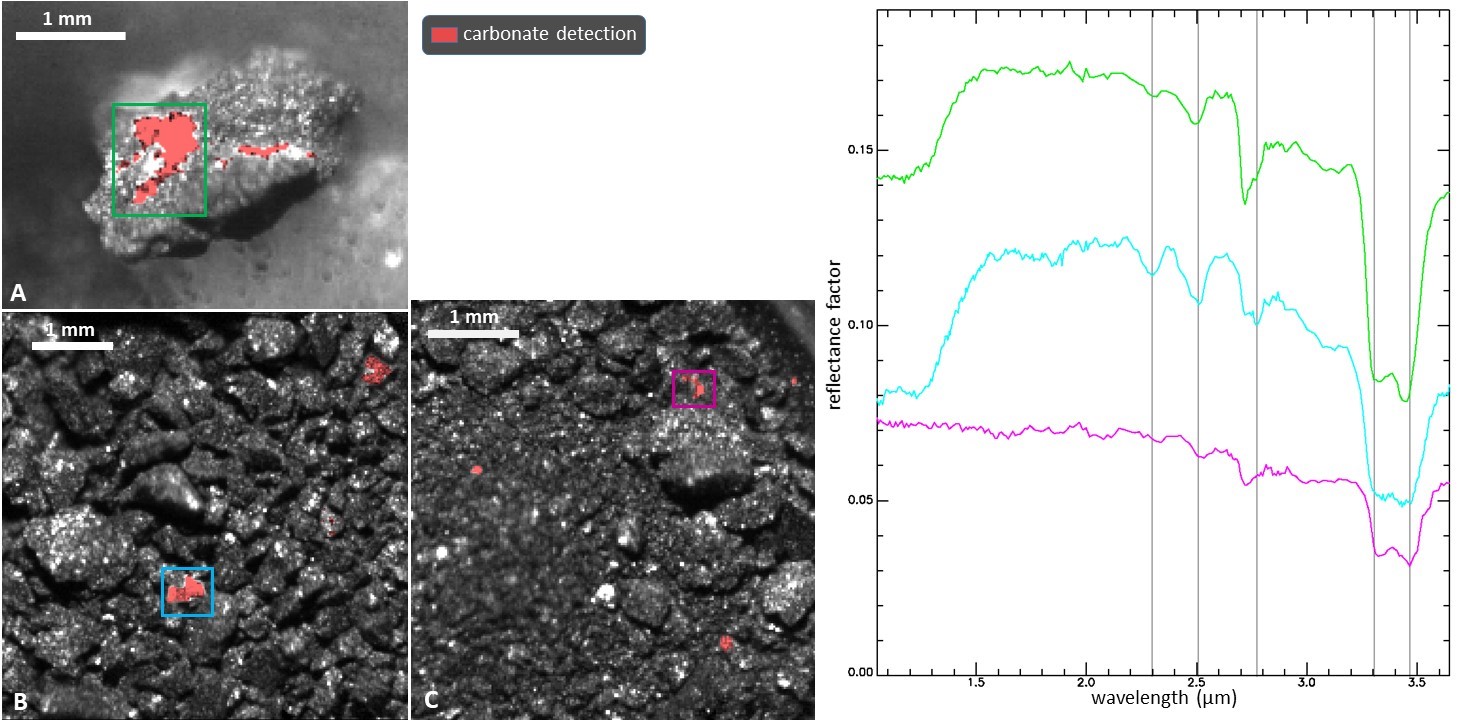
Figure 1. Example of carbonate detections highlighting carbonates as red pixels. Left: MicrOmega images with A: extracted grain C0041. B: bulk samples from chamber A. C: bulk samples from chamber C. Right: Average spectra of pixels with carbonate detections within the colored boxes in the left images.
Results: When analyzed at the mm-scale by averaging thousands of pixels, the spectra of bulk A and bulk C exhibit a pattern similar to those acquired remotely down to the meter scale by the NIR spectrometer NIRS3 on board Hayabusa2 [6]. The global reflectance is extremely low, 2-3 %, in agreement with the measurements of the ONCs (Optical Navigation Cameras) and NIRS3 at Ryugu [7,8], and consistent with the taxonomic spectral classification of Ryugu as a C-type asteroid [1,2]. The main spectral feature is the diagnostic OH absorption centered at 2.715 +/- 0.005 µm, position compatible with that of NIRS3 spectra [8,9]. MicrOmega spectra also exhibit a broad feature in the 3.3-3.5 µm range, centered around 3.4 µm, present throughout the sub-bulk samples. This feature is considered indicative of the large-scale presence of a variety of CH- rich compounds and carbonates. A fainter ~3.1 µm broad feature, indicative of the presence of NH-bearing compounds is also detected, although with varying and much fainter intensities. At a sub-millimeter scale, however, heterogeneities do clearly show up, either or both at grain level or as inclusions within grains. Detections include for example: 1) carbonates of various compositions, detected on a rather large number of occurrences with sizes ranging from a few tens to a few hundreds of micrometers (see a few examples Fig. 1) ; 2) spots enriched in organics, in particular through a 3.4 µm feature indicative of the presence of aliphatic compounds (see one example Fig. 2) ; 3) spots enriched in a nitrogen-rich phase, through a ~3.1 µm feature sometimes coupled to additional spectral features. These detections, as well as others, will be presented and candidates will be discussed. Noticeably, no chondrules nor refractory inclusions have been identified so far.
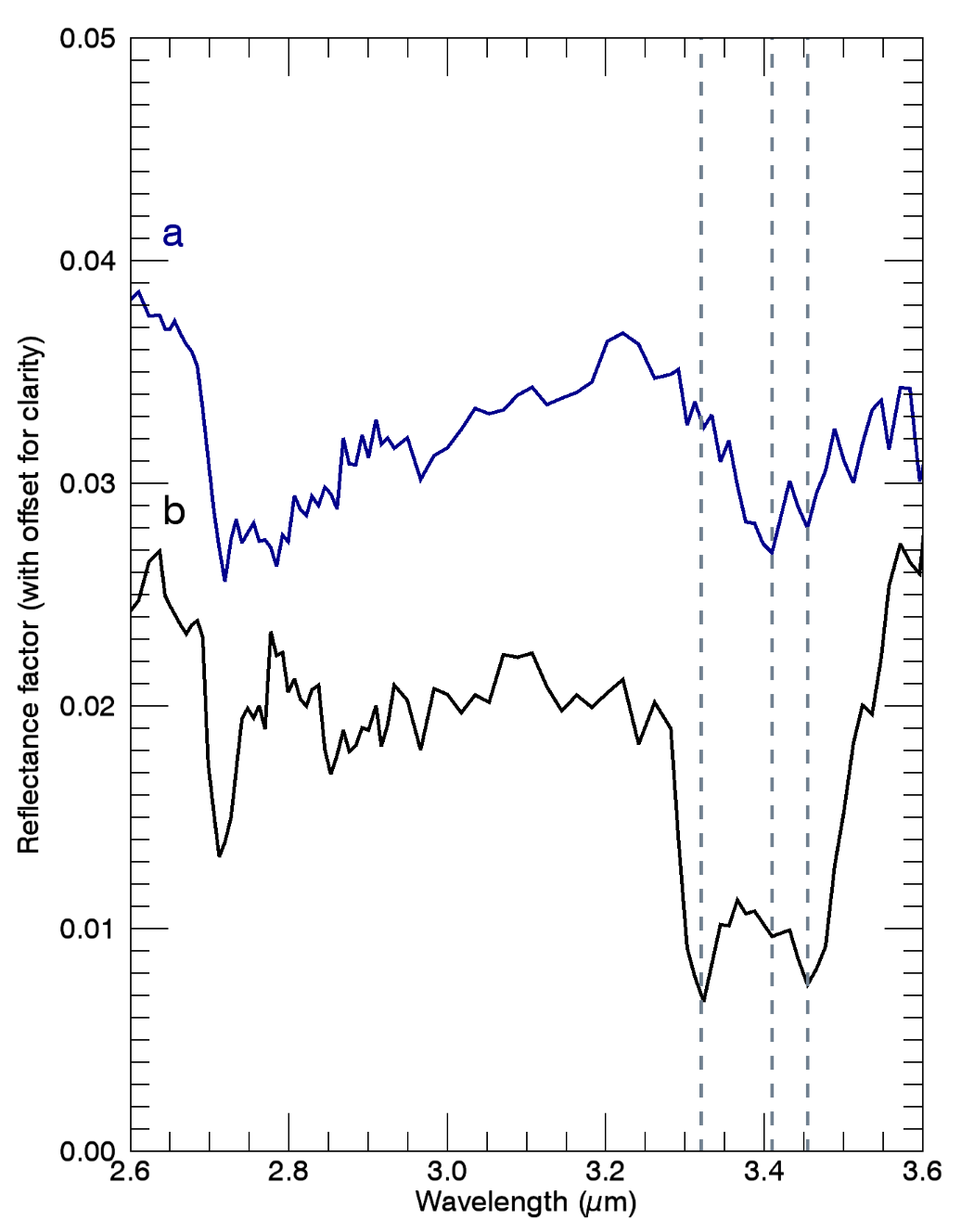
Figure 2. CH-rich spectrum on a localized spot within bulk A (a) compared to a typical spectrum of a carbonate rich spot (b),emphasizing the diagnostic difference of the “3.4 µm” feature. Both spectra are 3×3 pixels average spectra. Dashed lines are set at 3.32 µm, 3.41 µm and 3.455 µm to highlight the differences in band position and shape [6].
Conclusion: The initial spectral characterization of the returned samples by MicrOmega currently points towards Ryugu containing a fascinating variety of grains, including OH-, CH- and NH-rich compounds spread at a global scale, and alteration products, among which highly diagnostic carbonates in a variety of cation contents. The occurrence of volatile-rich species, likely originating from the outer solar system, would support Ryugu having preserved some of its pristine constituents, together with their partially altered phases. The Hayabusa2 returned samples, thus, appear among the most primordial material available in our laboratories.
References: [1] Binzel R. P. et al. (2002), Physical Properties of Near-Earth Objects. pp. 255-271, [2] Vilas F. (2008) The Astronomical Journal 135 (4), 1101-1105, [3] Morota et al. (2020) Science 368, Issue 6491, pp. 654-659, [4] Yada, T., et al., Nature Astronomy, 2021, Volume 6, p. 214-220, [5] Bibring J.-P. et al. (2017) Astrobiology 17, Issue 6-7, pp.621-626, [6] Pilorget, C., et al., Nature Astronomy, 2021, Volume 6, p. 221-225, [7] Sugita S. et al. (2019) Science 364 (6437), 252-252, [8] Kitazato K. et al. (2019) Science 364 (6437), 272-275, [9] Kitazato K. et al. (2020) Nature Astronomy, Volume 5, p. 246-250.
How to cite: Loizeau, D., Pilorget, C., Bibring, J.-P., Okada, T., Brunetto, R., Yada, T., Riu, L., Usui, T., Hatakeda, K., Nakato, A., Yogata, K., Abe, M., Aleon-Toppani, A., Baklouti, D., Carter, J., Langevin, Y., Lantz, C., and Le Pivert-Jolivet, T. and the MicrOmega Hayabusa 2 Curation Team: NIR Hyperspectral Imaging of Hayabusa 2 Returned Samples by the MicrOmega Microscope within the ISAS Curation Facility, Europlanet Science Congress 2022, Granada, Spain, 18–23 Sep 2022, EPSC2022-898, https://doi.org/10.5194/epsc2022-898, 2022.
Introduction: JAXA’s Hayabusa2 asteroid sample return mission targeted the carbonaceous (C-type) asteroid 162173 Ryugu. The Hayabusa2 spacecraft collected samples from two touchdown sites on Ryugu and returned them to Earth on December 6, 2020, six years after launch. Since then, the goal of the Insoluble Organic Macromolecule Initial Analysis Team (PI: H. Yabuta) has been to elucidate the distributions and chemical characteristics of macromolecular organic materials in a C-type asteroid [1]. The degree of structural order of the polyaromatic carbonaceous matter present in extraterrestrial samples is a tracer of the thermal history they experienced (e.g., primitive chondrites: [2-5]; micrometeorites: [6-7]). To characterize Ryugu’s thermal history (long vs. short thermal heating and its extent), we thus perform Raman characterization of several intact grains and also on extracted insoluble organic matter from aggregates originating from the two collecting sites. In order to be fully confident in the obtained data and interpretation, Raman characterization was led independently by two groups in Japan and in France on distinct Ryugu particles.
Samples and methods: Raman point analyses were performed on several fragments of several intact grains from Chamber A aggregates (A0108, A0106) from the first touchdown site and six intact grains from Chamber C aggregates (C0109, C0057) from the second touchdown site. The insoluble carbonaceous residue isolated by acid treatment from the same aggregates have also been characterized and the data are currently being interpreted.
The Raman spectra were acquired with a 532 nm laser in both Japan and France. Because some Raman bands related to carbonaceous matter are dispersive, data for Ryugu particles and comparison samples have been acquired and analyzed consistently in both Japan and in France. In particular, in France, Raman measurements were performed at the Ecole Normale Supérieure de Lyon (Laboratoire de Géologie de Lyon—Terre, Planètes, Environnement) using a LabRam HR800 Raman spectrometer (Horiba Jobin-Yvon) equipped with a 600 g/mm grating. The laser was focused through a 100× objective to obtain a <2 μm spot size. The power on the sample was 0.3 mW. Each acquisition comprised six integrations of 15 s that were averaged to make the final spectrum.
Results and Discussion: The Raman data acquired in Japan and in France are fully consistent. Each acquired spectrum is characterized by a high fluorescence background and by the presence of the Raman D- (~ 1350 cm-1) and G-bands (~ 1580 cm-1), related to the presence of poorly ordered carbonaceous matter. The spectral parameters derived from the mathematical fitting of the individual spectra - band widths (FWHMD, FWHMG), band positions (ωD, ωG), and band intensity ratio (ID/IG) - are all clustering in the same area (Fig. 1).
In order to evaluate the thermal history of the Ryugu asteroid, the spectral parameters derived from Ryugu’s samples were compared with those obtained on meteorites. In a plot FWHMGvs. ωG (Fig. 1B), the Ryugu samples are clearly distinct from petrologic type 3 chondrites. In the plots FWHMDvs. ID/IG (Fig. 1C) and ωGvs. ωD (Fig. 1D), the parameters from Ryugu samples are comparable to those derived from the primitive Ivuna-type (CI) and Mighei-type (CM) carbonaceous chondrites of petrologic types 1 and 2, respectively. On the other hand, they are distinct from thermally metamorphosed CM chondrites, such as Wisconsin Range (WIS) 91600, Pecora Escarpment (PCA) 02012, and Jbilet Winselwan meteorites.
The interpretation of spectral data acquired on IOM is currently under progress. The spectral parameters are consistent with those derived from IOM extracted from primitive chondrites, as expected from the data obtained on intact particles.
These results indicate that Ryugu escaped significant long duration radiogenic thermal metamorphism as well as significant impact induced short-duration heating. This is consistent with tracers visible on IR spectra of the intact particles: presence of Mg-rich phyllosilicates and CH2/CH3 ratios comparable with primitive chondrites [8].
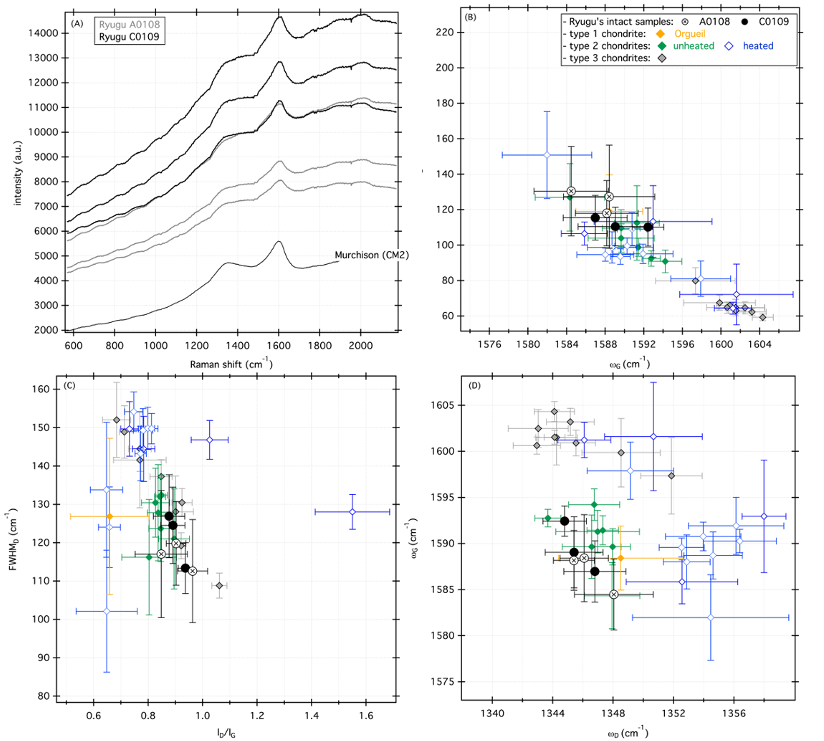
Acknowledgments: L.B. and E.Q. thank the French space agency CNES for its support.
References: [1] Yabuta et al. Submitted to Science – in revision [2] Bonal L. et al. (2006) GCA, 70, 1849-1863. [3] Bonal L. et al. (2016) GCA, 189, 312-337. [4] Busemann H. et al. (2007) Meteoritics & Planet. Sci. 42: 1387-1417. [5] Quirico E. et al. (2018) GCA, 241, 17-37. [6] Dobrica E. et al. (2011) Meteoritics & Planet. Sci. 46, 1363-1375. [7] Battandier M. et al. (2018) Icarus, 306, 74-93. [8] Kebukawa et al. (2022) LPSC abstract #1271.
How to cite: Bonal, L., Quirico, E., Montagnac, G., Komatsu, M., and Yabuta, H. and the The Hayabusa2-initial-analysis IOM team: Thermal history of Ryugu based on Raman and IR characterization of Hayabusa2 samples, Europlanet Science Congress 2022, Granada, Spain, 18–23 Sep 2022, EPSC2022-1131, https://doi.org/10.5194/epsc2022-1131, 2022.
Orals: Fri, 23 Sep, 12:00–17:00 | Room Andalucia 1
Introduction: Primitive asteroids that accreted beyond the snowline in the protoplanetary disk likely played a crucial role in the delivery of water and organic matter to Earth and other terrestrial planets. The surface of the Cb-type asteroid 162173 Ryugu has low overall reflectance and an absorption feature at ~2.7 µm consistent with the presence of carbonaceous materials and phyllosilicates [1]. The spectral characteristics of Ryugu’s surface are most similar to the highly altered CI (“Ivuna-like”) and/or dehydrated CY (“Yamato-like”) carbonaceous chondrites [2].
In December 2020, JAXA’s Hayabusa2 mission successfully returned to Earth with >5 g of sample collected from the surface of Ryugu. The initial investigation of the samples suggested a close affinity with the CI chondrites [3], which consist of abundant phyllosilicates (~80 vol.%), plus minor amounts of magnetite (~10 vol.%), and dolomite (<5 vol.%), having experienced low temperature (<100°C) aqueous alteration [4]. In contrast, the CY chondrites contain dehydrated phyllosilicates and/or recrystallized olivine (~70 vol.%), Fe-sulphides (up to ~20 vol.%), and sometimes metal (~1 vol.%) following post-hydration metamorphism at temperatures >500°C [5]. Here, as part of the Hayabusa2 “Stone” preliminary examination team, we have characterised the modal mineralogy of a Ryugu particle to further constrain its aqueous and thermal history.
Methods: A powdered sub-sample of Ryugu particle C0002 (plates 3 and 4) was analysed using position-sensitive-detector X-ray diffraction (PSD-XRD) at the Natural History Museum (NHM), London. XRD patterns were acquired from the Ryugu powder using a high-intensity micro X-ray source for 6 hours, with the sample rotated throughout the analysis. Pure standards of each phase detected in the Ryugu powder were analysed under exactly the same conditions for 15 minutes. The modal mineralogy of the Ryugu powder was then determined using an established peak fitting method [4, 5].
Results & Discussion: Ryugu particle C0002 (plates 3 and 4) contains a mixture of Mg-rich serpentines and smectites that are present at an abundance of ~84 (± 2) vol.%. Other phases identified from the XRD pattern include magnetite (~8 vol.%), pyrrhotite (~7 vol.%), and dolomite (~2 vol.%). This mineralogy is broadly consistent with our petrographic observations of polished Ryugu sections (C0025-01 and C0103-02). Diffraction peaks from anhydrous olivine and pyroxene were not observed suggesting that their abundance is ≤1 vol.% in the analysed fraction of C0002. If we assume a maximum anhydrous silicate abundance of 2 vol.%, then the phyllosilicate fraction (PSF = total phyllosilicate abundance / [total anhydrous silicate + total phyllosilicate abundance]) of the Ryugu powder is 0.98, which corresponds to a petrologic sub-type of 1.1 on the alteration scale of Howard et al. [6].
The XRD pattern and modal mineralogy of Ryugu particle C0002 (plates 3 and 4) is very similar to the CI chondrites [4]. However, the Ryugu powder does not contain sulphates and ferrihydrite, which are common in the CI chondrites and thought to be terrestrial weathering products [7]. The Ryugu powder also has a comparable mineralogy to the recent C2ung fall Tarda, which appears to be related to the Tagish Lake (C2ung) meteorite [8]. However, Tarda retains partially altered chondrules and has a relatively high abundance of anhydrous silicates (~10 vol.%) [9]. In addition, the XRD pattern and modal mineralogy of the Ryugu powder is clearly distinct from the CY chondrites, which contain dehydrated phyllosilicates that lack coherent diffraction, and abundant poorly crystalline troilite and secondary olivine [5].
The modal mineralogy of Ryugu particle C0002 (plates 3 and 4) is consistent with having formed through low temperature aqueous alteration. The fluid-rock reactions reached near-completion, resulting in a secondary assemblage of phyllosilicate, sulphide, magnetite, and Mg-carbonate that was not overprinted by a later episode of thermal metamorphism at temperatures >~400°C.
References: [1] Kitazato et al. (2019) Science. 364:272. [2] Kitazato et al. (2021) Nature Astronomy. 5:246. [3] Yada et al. (2022) Nature Astronomy. 6:214. [4] King et al. (2015) Geochimica et Cosmochimica Acta. 165:148. [5] King et al. (2019) Geochemistry. 79:125531. [6] Howard et al. (2015) Geochimica et Cosmochimica Acta. 149:206. [7] Gounelle & Zolensky (2001) Meteoritics & Planetary Science. 36:1321. [8] Marrocchi et al. (2021) The Astrophysical Journal Letters 913:L9. [9] King et al. (2021) 52nd LPSC, abstract #1909.
How to cite: King, A., Russell, S., Nakamura, T., Yurimoto, H., Noguchi, T., Okazaki, R., Yabuta, H., Naraoka, H., Sakamoto, K., Tachibana, S., Watanabe, S., and Tsuda, Y.: The modal mineralogy of asteroid 162173 Ryugu and its relationship to carbonaceous chondrite meteorites, Europlanet Science Congress 2022, Granada, Spain, 18–23 Sep 2022, EPSC2022-1264, https://doi.org/10.5194/epsc2022-1264, 2022.
1. Introduction
Hayabusa2 – Japanese Aerospace Exploration Agency Mission investigated the asteroid (162173) Ryugu and on 06 December 2020 successfully returned to the Earth ~5.4 g of collected materials. Indeed, the first touch-down operation (TD1) sampled surface material on 21st February 2019; after the formation of a 15 m artificial crater with the SCI operation (Saiki et al., 2013), the TD2 occurred on 11st July 2019 and collected samples in the vicinity of crater, probably also subsurface material excavated by the impact. Ryugu appears to be a rubble-pile asteroid due to the low density (about 1.2 g/cm3) which suggests a formation by re-accumulation of fragments generated by the catastrophic destruction of the parent body (Watanabe et al., 2019). NIRS3 spectra of Ryugu surface acquired during Hayabusa2 mission show a strong features at 2.7 μm (indicating a OH-rich content ascribed to Mg-rich phyllosilicates) (Kitazato et al., 2019) and a secondary absorption at about 2.8 μm, strongly correlated with the 2.7 μm band (Galiano et al., 2020).
This work includes the Carbonaceous Chondrite meteorites (CCs) identification and selection in grains from ~1 to 4mm to simulate the Ryugu surface and analogue mixtures production by using different end-members: a dark component (graphite, carbon, etc.), Mg-rich phyllosilicates (i.e. Antigorite for OH stretching band at 2.7 μm) and Fe-rich dark component (e.g. Cronstedtite) to reproduce the 0.7 and 2.8 μm bands of Fe-bearing phyllosilicates. Four analogue mixtures have been sieved in the grain size 100-200 μm and 200-300 μm and named: Mixture#3, Mixture#4, Mixture#5 and Mixture#6. The spectra of the samples have been acquired by means of Bruker Vertex 80 FT-IR Spectrometer (incidence angle of 30° and emission angle of 0°) in the spectral range 2-4 μm (spectral resolution of 4 cm-1) and then compared with average Ryugu spectrum. The spectral slope (in the 2.0-2.5 μm range), Band Depth and Band Center of the feature at 2.7μm and reflectance at 2.1μm have been analysed.
2. CCs meteorites analysis
The acquired meteorites spectra (fragments) compared with Ryugu ones are reported in Figure 1. The results show as the reflectance (at 2.1μm) values of meteorites (0.042 Murray, 0.032 Nagoya and 0.030 Nagoya) can be comparable with Ryugu reflectance level, i.e. 0.0296 as well as the BC (2.731 Murray, 2.749 Nagoya and 2.716 Nagoya and 2.719 of Ryugu spectra). Differently, the meteorites BD is from four to eight times more intense than Ryugu one.
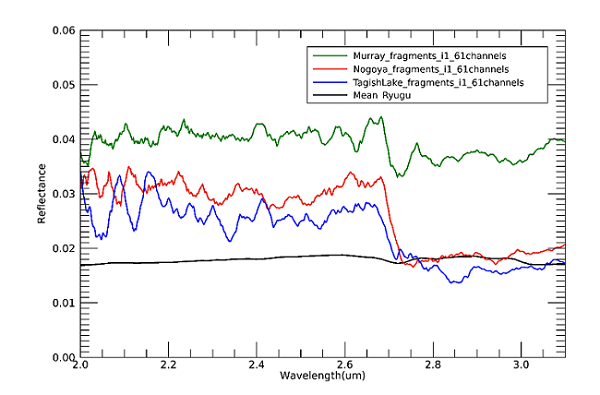
Figure 1. Meteorites spectra and comparison with Ryugu (smoothed with 61 channels).
3. Analogue mixtures analysis
The analogue mixtures (about 0.1g) have been produced by considering the grain size of 100-200 µm and 200-300 µm (Figure 2). Each end-member has been analysed in the spectral range of interest, for example the Antigorite shows the bands at 2.3 µm (due to combination of Mg-O-H bending and O-H stretching) and at 2.7 µm (O-H stretching).
Figure 2. Percentage composition of Ryugu analogue mixtures.
The Figure 3 at left shows the spectra of Mixture #3 and #4 while at right the Mixture #5 and #6 compared with the mean spectrum of Ryugu (obtained by NIRS3 data) multiplied by 7 for a better comparison. The Mixture#3 does not show the contribution of OH bands due to high percentage of dark component, i.e. 42.5%. Thus, the Mixture#4 has been produced by increasing the Mg-rich phyllosilicates, reducing the dark component and introduce the Cronstedtite (Fe- bearing phyllosilicate). So that, it is important to introduce an additional dark component, i.e. the Cronstedtite (Fe- bearing phyllosilicate) which can help to decrease the reflectance level and to contribute to shallow 2.7 µm band due to OH.
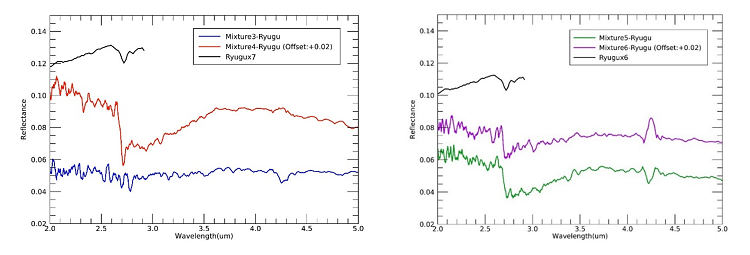
Figure 3. Analogue mixtures compared with average Ryugu spectrum.
4. Preliminary results and future aims
The mixtures #4, #5, #6 showed a negative spectral slope due to the high percentage of Antigorite (up to 60%) responsible of the 2.7 μm band while 3 μm spectral band has been ascribed to the adsorbed atmospheric water. Furthermore, the Cronstedtite included in the Mixture#6 gave a contribution to the dark component equal to 32.5% by avoiding negative effects on 2.7 μm spectral band that remains to be well defined. Preliminary analysis exhibit a good comparison between Ryugu BC and analogue mixtures BC (due to the presence of Mg-phyllosilicate) whereas the BD in spectra of analogue mixtures is deeper than the Ryugu one. The Ryugu reflectance is two-three times lower than the mixtures reflectance and characterized by a positive spectral slope, contrarily to the mixtures’ spectra which have a negative spectral slope. Starting from Mixture#6, next step will aim at reducing the reflectance level and decrease the OH band contribution, as well as producing a positive spectral slope. By using thermal controlled setup in vacuum chamber at different temperatures (e.g. 100, 200, 300, 400°C), a thermal metamorphism can be simulated and new spectra will be acquired. In the future, laser and ion irradiations can be considered to simulate the micrometeorite impacts and solar wind processes which help to decrease the spectral level and increase the spectral slope, as well as to reduce the analogue mixtures spectral bands.
References: Galiano A., et. al. 2020, Icarus, v. 351, 113959; Kitazato, K. et al. 2019, Science 364, 6437: 272-275; Saiki, T., et al. 2013, Acta Astronautica, v. 84, 227-236; Tatsumi, E. et. al., 2021, Nat Commun 12, 5837; Watanabe, S. et al., 2019, Science 364, 6437: 268-272
How to cite: Dirri, F., Palomba, E., Galiano, A., Longobardo, A., Gisellu, C., and Angrisani, M.: VIS-NIR reflectance analysis of (162173) Ryugu analogues mixtures and CC meteorites in the framework of Hayabusa2 mission, Europlanet Science Congress 2022, Granada, Spain, 18–23 Sep 2022, EPSC2022-154, https://doi.org/10.5194/epsc2022-154, 2022.
Sensitive laboratory instruments on Earth are capable of determining the chemical, isotopic, mineralogical, structural, and physical properties of extraterrestrial samples from the macroscopic level down to the atomic scale, allowing to determine the origin and history of the material and answer questions far beyond the reach of current robotic technology. Sample return provides us with “ground truth” about the visited body, verifying and validating conclusions that can be drawn by remote sensing (both Earth-based and by spacecraft) and via landed instruments on other bodies. Returned samples can be compared to meteorites and cosmic dust using the same instrumentation, which apart from giving us clues about where those materials come from, potentially increases their scientific value as natural space probes. And finally, returned samples can be preserved for decades and used by future generations. The detailed investigation of the mineralogy and geochemistry of Ryugu plays a fundamental role in the understanding of its formation processes, and thereby gather further knowledge about the building blocks of the solar system. Based on the preliminary data from remote sensing measurements and laboratory-based measurements, Ryugu is rich in hydrated carbonaceous chondrite (CC) like material and more specifically it is very similar to Ivuna-like (CI) carbonaceous chondrites [1]. These meteorites are characterized by a high abundance of phyllosilicates and organic matter [2], which makes them have a low albedo. However, Ryugu seems to be even darker than CIs, as well as being more porous and fragile [1].
If Hayabusa2 samples are made available to our consortium, we will use a multi-pronged approach to achieve two main goals. The first goal is to address a fundamental challenge in the interpretation of remote sensing data which was seen during the initial analysis of the Hayabusa 2 samples. Observations of planetary surfaces using spectroscopy have shown subdued contrast compared to measurements performed under laboratory conditions on analog materials. A strong focus of the work performed at PSL over the last decade has been to understand - and if possible minimize - the difference between laboratory and remote sensing observations (e.g. [3,4,5,6]). Simulating the conditions on the target body as well as accurately reproducing the observing geometries have gone a long way towards that goal, however differences remain. A suggested explanation is the difference between terrestrial analog materials including even meteorites and the surfaces of planetary bodies. With Ryugu samples this hypothesis can be tested further, leading to a deeper understanding of the link between laboratory and remote sensing observations and thus benefiting not only the analysis of Hayabusa 2 data but of all remote sensing observations of planetary surfaces using spectroscopy.
The second goal building on this is an investigation of the mineralogy and organic matter of the samples collected by Hayabusa 2, to better: a) understand the evolution of the materials characterizing asteroid Ryugu and therefore advance our knowledge of the mineralogy of the protoplanetary disk and organic matter (OM); b) investigate the aqueous alteration that took place in the parent body that lead to its current chemical and mineralogical characteristics; c) compare the results with data collected from pristine carbonaceous chondrite meteorites rich in hydrated minerals and organic matter.
To prepare for measurements on Hayabusa 2 returned samples, we selected a small particle from the Mukundpura meteorite, a recently fallen meteorite that is considered as one of the best Ryugu analogs in the meteorite collection [7]. We have chosen a piece with a 4mm diameter, typical of the larger grains available in the Hayabusa 2 sample collection. We manufactured for this purpose a special sample holder for reflectance measurements in the FTIR spectrometer.

Figure 1. (left): 4mm particle and the whole Mukundpura at PSL; (right): the 4mm particle in our sample holder.
Figure 1 shows the small 4 mm selected Mukundpura particle compared with the whole sample available at PSL and its special sample holder. We adapted our standard measurement set-up reducing the aperture to fit the size of the samples. With this configuration we obtained measurements as shown in Figure 2, where MIR spectrum of the 4mm Mukundpura particle, obtained reducing the aperture of our light source beam to the minimum, 0.25 mm is compared with a measurement of the same meteorite acquired with a much larger aperture (4mm, as standard).
Figure 2. Mukundpura bulk sample measured with traditional beam aperture of 4 mm (light-blue) and with reduced aperture (0.25 mm) on the small 4mm piece of the same meteorite. Below 9 µm we observe a lower reflectance of the piece compared to the bulk - reminiscent of what was observed in the preliminary investigation for the Hayabusa 2 sample.
It’s evident that with the reduced beam aperture, we are able to obtain high quality FTIR spectra of an Hayabusa 2 sample by just using our traditional spectroscopic set-up and compare to the thousands of spectra measured at PSL on a wide range of analogs including meteorites.
Raman spectroscopy complements IR spectroscopy in the determination of the mineralogical composition of the sample. It is performed in a contactless manner, and under neutral (e.g. nitrogen) atmosphere thanks to the long working distance objective. Figure 3 shows our tests on the Mukundpura particle; different measurement modes were used to reveal the presence of olivine, carbon, and magnesium silicates.
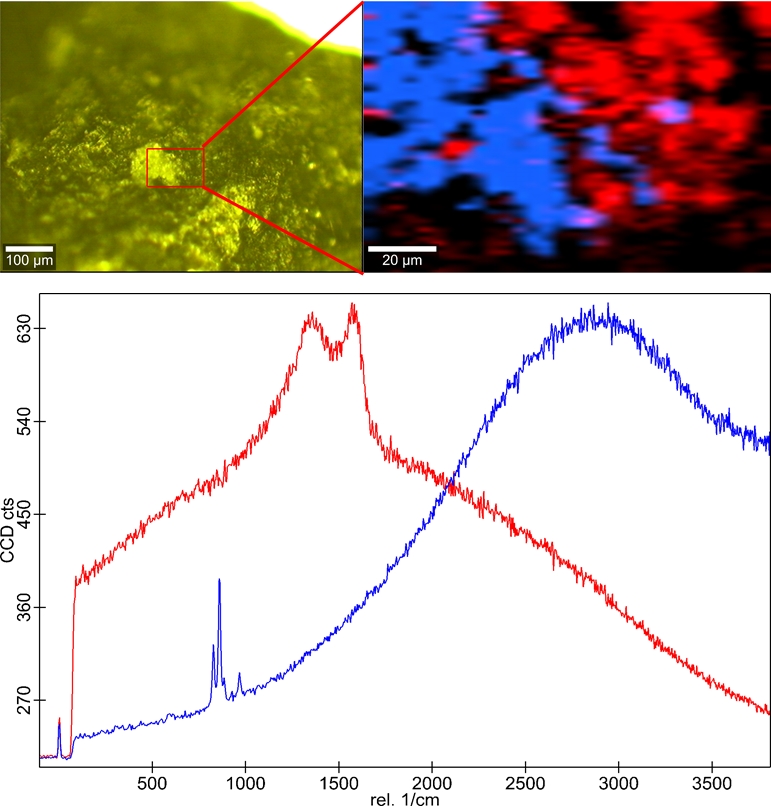
Figure 3. Example using the Mukundpura particle of an image scan of 30 points per line and 60 lines per image on a 120 x 80 µm area. The blue color denotes the presence of the olivine doublet (827 and 859 cm-1) and red the presence of carbon D and G bands (1340 and 1568 cm-1).
[1] Yada, T., Abe, M., Okada, T. et al., 2022. Nat Astron 6, 214–220. [2] Cloutis, E. A., et al., 2011. Icarus, 212:1.. [3] Maturilli, A., et al., 2016a. Earth, Planets and Space 68(1). [4] Maturilli, A., et al., 2016b. Earth, Planets and Space 68(1). [5] Beck, P., et al., 2018. Icarus 313: 124-13. [6] Yesiltas, et al., 2020. Meteoritics & Planetary Science, 55(11): 2404–2421. [7] Ray, D. and Shukla, A.D., 2018. PSS 151, 149-154.
How to cite: Maturilli, A., Schwinger, S., Bonato, E., Hamm, M., Helbert, J., Baque, M., Alemanno, G., and D'Amore, M.: Spectroscopic measurements on a Mukundpura meteorite grain as training for the analysis of Hayabusa2 returned samples, Europlanet Science Congress 2022, Granada, Spain, 18–23 Sep 2022, EPSC2022-489, https://doi.org/10.5194/epsc2022-489, 2022.
Introduction: Meteorites, which are the remnants of our protoplanetary disk, provide a rich source of chemical information to investigate the origin of organic matter that have fallen on Earth and may have thus contributed to the emergence of life. Among meteorites, carbonaceous chondrites that contain organic matter are among the most primitive materials in the Solar System. Asuka 12236, found in Antarctica in 2012, has been classified as a member of the CM group. According to the first mineralogical analyses (Kimura et al., 2020, Nittler et al., 2021), Asuka 12236 is among the most primitive member of this group showing very few signs of aqueous alteration in its mineralogy.
Here, we have performed an overview of the soluble organic matter (SOM) present in this primitive meteorite, and compared it with other carbonaceous chondrites of the same family group. Two types of analysis were carried out on the SOM: a non-targeted analysis and then a targeted one on the basic so-called building blocks of life such as nucleobases and amino acids.
Methods: At first, we measured the global carbon content of our samples by elemental analysis using two grains of 2 mg each.
For the non-targeted high-resolution analysis of the SOM, 17 mg of the meteoritic material were used to extract the SOM with solvents allowing the preservation of meteorite organics (Schmitt-Kopplin et al. 2010). The fragment was crushed and successively extracted with dichloromethane, hexane and methanol at room temperature. The extracts were analyzed by FTICR (Fourier-Transform Ion Cyclotron Resonance) within a mass range of 150-1000 m/z.
For the analysis of the amino acids and nucleobases, 226 mg were extracted in water for 24h at 100°C. Aliquots were collected after centrifugation. Two UPLC-MS analyses have been performed (Serra et al., 2022) on these aliquots: the first was a screening from 50 to 750 m/z done with a Q-exactive Orbitrap coupled with a HILIC column. The second analysis has been done with a chiral column, allowing separation of targeted amino acids and information on a possible enantiomeric excess. This chiral analysis is coupled with UPLC- Multiple Reaction Monitoring (MRM-MS) MS analyses.
Identification and quantification of the molecules were done by dosed addition using 54 amino acids and 5 nucleobases (Adenine, Guanine, Cytosine, Thymine, Uracil), ensuring the right identification of the isomers. Note that our protocol does not include HCl hydrolysis step of the extracts, neither a derivatization procedure.
Results and Discussion: Elemental analysis (EA) done on 2 different fragments reveal the heterogeneity of our sample, in addition to the grains analyzed by Nittler et al., 2020, likely showing different alteration degrees in the chondrite (Fig. 1). We observe a correlation of carbon and nitrogen abundances in all grains of N/C ~ 0.05. From its H content, which can be extrapolated as the quantity of water, Asuka 12236 falls near the less altered CM chondrites, relatively close to the heated ones (EET and MIL CMs) (Alexander et al., 2012), while no sign of heat above 250 °C is observed on its mineralogy (Kimura et al., 2020).
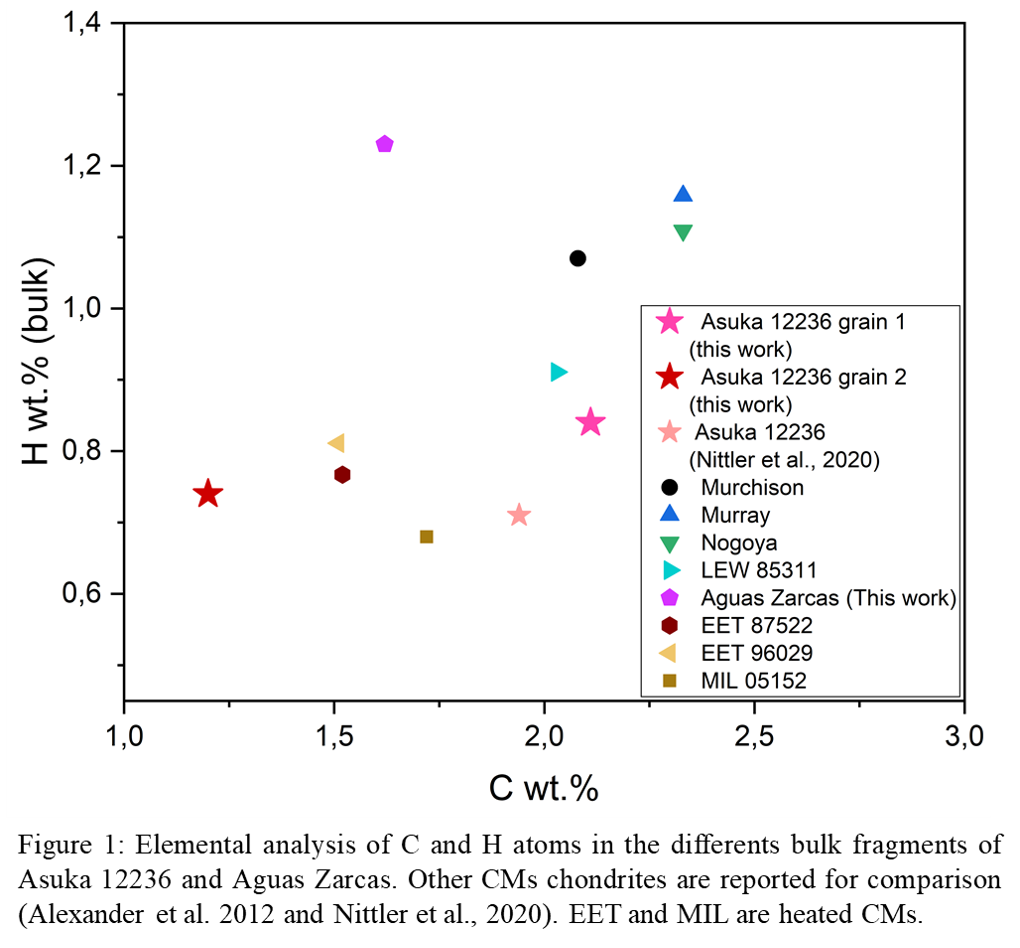
Electrospray ionization in negative mode FTICR analyses of the methanol on Asuka SOM reveal a global chemical composition of C, H, N, and O molecules up to 13211 different formulae (Fig. 2). The CHONS family contains the major chemical compounds for 41 % followed with CHOS family for 34 %. Such sulfur rich compounds can be related to the high abundance of mineral sulfide observed in the Asuka matrix (Kimura et al., 2020) and found by elemental analysis (2.4 wt.%). Compared to others CMs, such as Murchison and Aguas Zarcas, measured with the same instrument, Asuka has a similar SOM diversity with more sulfur organic compounds. The Paris meteorite, also among the least altered chondrites (Marrocchi et al., 2014), has half in amount of compounds with a similar relative abundance in sulfur containing compounds as Asuka in its methanol SOM.
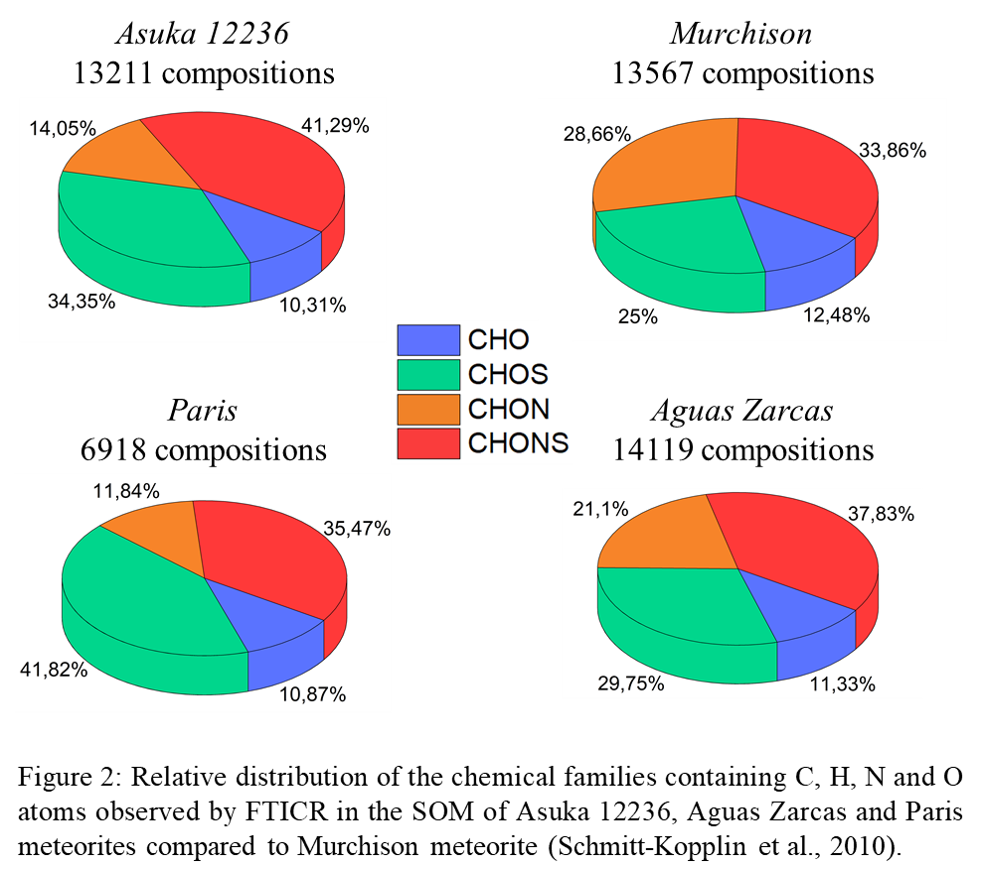
The UPLC-HRMS method allows a rapid screening of small polar molecules. We observe a huge diversity of small compounds (<200m/z), with more intense signals than those obtained from Aguas Zarcas (Serra et al.; 2020).
Target analysis performed with chiral column allow the identification and quantification of roughly 40 different amino acids. None of the natural nucleobases has been firmly identified, but some masses seen by UPLC-HRMS method do correspond to possible nucleobases isomers (Ruf et al., 2019).
Overall, our analysis results in the observation of a very diverse compounds in Asuka 12236, similar to what is observed in more aqueously altered chondrites (Murchsion and Aguas Zarcas). In agreement with Glavin et al., 2020, we confirm the high concentration and diversity of amino acids, together with the identification of new ones in our extract of the meteorite (Fig. 3).
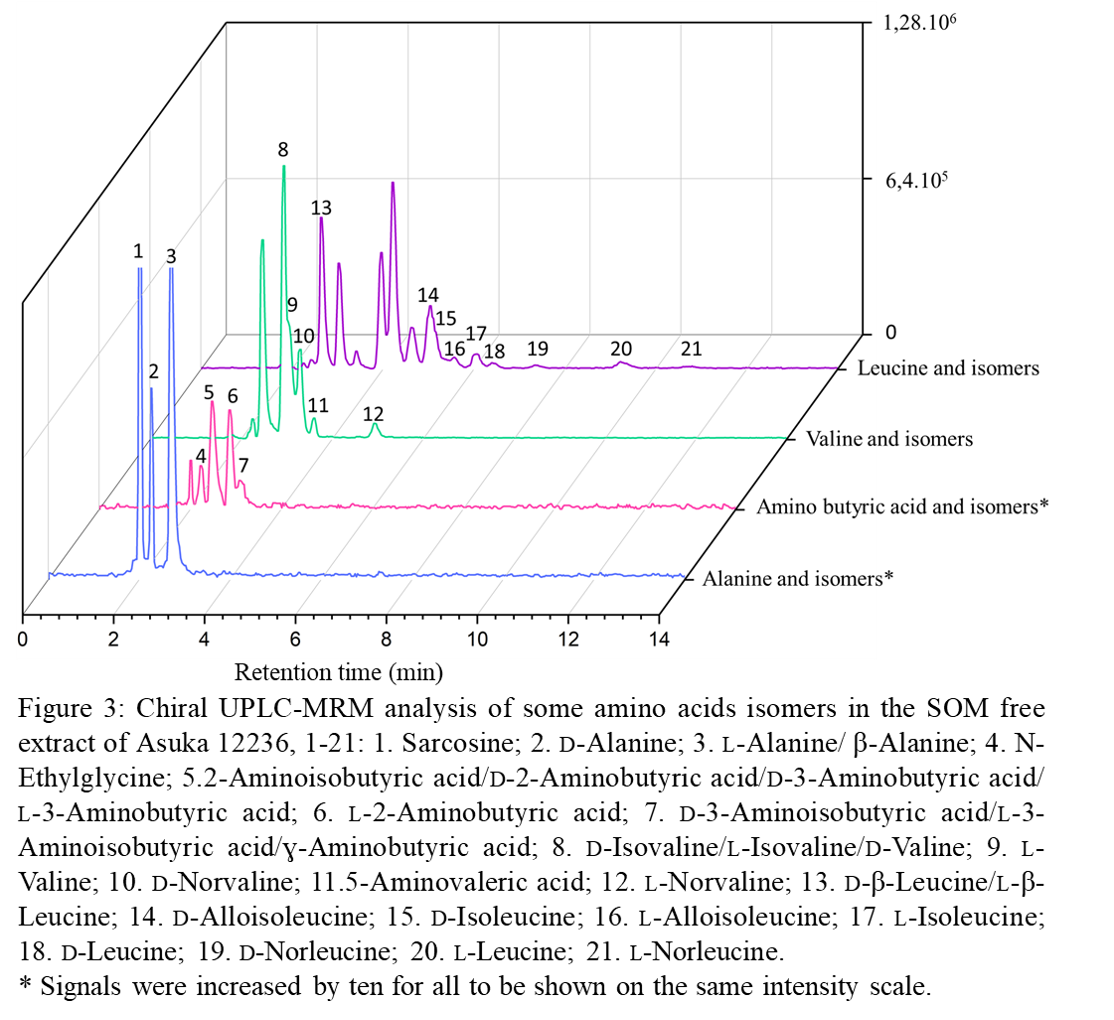
Such diversity, in amino acids and in global molecular composition, in addition to the quite high H wt.% indicates that the OM in Asuka 12236 has likely been altered during aqueous alteration, however still less than Murchison. It is also possible that Asuka 12236 presents more than one lithology, as seen with the three different results by EA, which can be related to the CI/CM clast seen in the matrix (Nittler et al., 2021). The chemical composition of the Asuka 12236 meteorite points toward a very rich and diverse composition but still needs further investigation in comparison to other meteorites to hypothesize on its origin and possible precise degree of alteration by aqueous processes.
Aknowledgements: We thank Philippe Clayes for the Asuka 12236 sample coming from the Asuka collection retrieved by expedition in Antartica by VUB-ULB and the Royal institute of the Natural Sciences in Bruxelles.
This study was partially funded by the Deutsche Forschungs-gemeinschaft (DFG, German Research Foundation) – Project-ID 364653263 – TRR 235 (CRC 235)
References:
Kimura. M. et al., (2020), Polar Science, (26), p100565.
Marrocchi et al. (2014), Meteoritics and planetary science 49.
Nittler et al., (2021), Meteoritics and planetary science 56
Ruf et al., (2019). The Astrophysical Journal Letters, 887
Schmitt-Kopplin. P. et al., (2010), PNAS, 107 (7) p 2763-2768
Serra. C. et al., (2022), Talanta (Oxford), (243), p123324
How to cite: Serra, C., Vinogradoff, V., Poinot, P., Duvernay, F., Le Sergeant d'Hendecourt, L., and Schmitt-Kopplin, P.: Overview of the organic matter present in Asuka 12236: a primitive meteorite?, Europlanet Science Congress 2022, Granada, Spain, 18–23 Sep 2022, EPSC2022-546, https://doi.org/10.5194/epsc2022-546, 2022.
1/ Introduction
The incorporation and evolution of nitrogen (N) in the early Solar System, as well as the origin of terrestrial nitrogen, are still very poorly understood. Across the Solar System, the isotopic composition of nitrogen is far from being uniform (from δ15N = –387 ± 8‰ in the Solar Wind to δ15N = +850 ± 150‰ in nitrogen species in cometary coma) and seems to reflect different processes leading to distinct isotopic reservoirs [e.g., 1]. As carbonaceous chondrites (CC) are the richest in volatiles [2] among primitive meteorites, the measurements of their nitrogen isotopic composition are a key to investigate the origins and evolutions of this element in the Solar System.
As for CCs [3], the nitrogen in comets is considered to be mainly present in the refractory organic material [4]. However, nitrogen in the form of ammonium salts have been identified on comet 67P/Churyumov-Gerasimenko [5] and may constitute the dominant reservoir of nitrogen in comets [5, 6]. Ammonium may also be present on several asteroids [5, 7] and might be present in Hayabusa2-returned samples among NH-rich compounds [8]. Ammonium could therefore constitute a dominant nitrogen reservoir of these objects, and may have been delivered in abundance to Earth through carbonaceous chondrites.
In 1864, 0.1wt% of ammonium was detected in the Orgueil meteorite, just after its fall [9], but has never been reported since then. Is the ammonium detected in 1864 still present in the meteorite nowadays? Is it a terrestrial contamination? If extraterrestrial, how much nitrogen is in the form of ammonium in Orgueil? How is nitrogen partitioned between ammonium, soluble and insoluble organic compounds? What are the genetic links between these nitrogen-containing phases? These are the questions we seek to address with the present work.
2/ Method
Because the Orgueil meteorite is known to be altered by the terrestrial environment [10] we have analysed two samples of Orgueil, that have been stored in different conditions. The so-called “Orgueil-Flask” (OF) is material recovered after the fall in 1864 and kept in a tightly sealed flask in a private collection. By contrast, the so-called “Orgueil-Museum” (OM) is a raw chip from the Orgueil sample kept in a sealed bell-jar, but possibly leaking, at the Museum Victor Brun de Montauban (France). OM grains/fragments are covered by relatively bright effloresced sulfates, which are minor in OF grains, indicating that the OF sample is probably less terrestrially altered.
To avoid any contamination by terrestrial ammonia, we have developed a contamination-free protocol to extract, quantify and measure the isotopic composition of nitrogen in Orgueil water-soluble ammonium (Figure 1). The meteorite is ground and solubilised in water to extract water-soluble ammonium. Grinding the meteorite fragment can heat the material, potentially leading to the evaporation of ammonium and/or to the decomposition of organic molecules forming ammonium or ammonia [11, 12, 13]. To overcome these issues and solubilise as much ammonium as possible, the meteorite fragment is ground under cryogenic conditions in a hermetic jar containing water ice. After grinding and water melting, ten series of leaching by ultra-sonification, followed by centrifugation, collection of the supernatant phase and re-solubilisation of the ammonium contained in the remaining powder are performed to extract all the water-soluble ammonium. The resulting solutions are analysed by Ion-exchange Chromatography (IC) and Isotopic Ratio Mass Spectrometer (IRMS) to quantify the ammonium content and measure its N-isotopy.
To investigate the partition of nitrogen in the meteorite, the nitrogen abundance and isotopic composition of the bulk samples and of the Insoluble Organic Material (IOM) extracted from these samples (adapted from the method described in [14]) are also measured by IRMS.
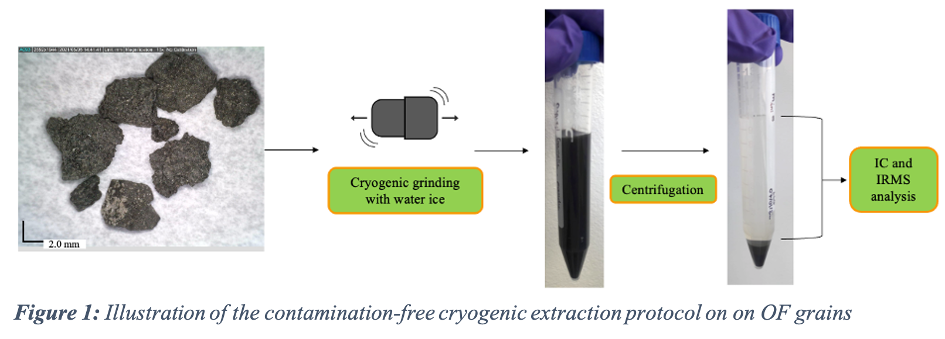
3/ Main results and conclusions
Duplicate analyses of the least altered sample (OF) reveal the presence of water-soluble ammonium at a concentration ranging from 0.053 to 0.083 weight percent by mass of meteorite with a mean value of 0.068 ± 0.015 wt% (Table 1). This concentration corresponds to a mean proportion of 28 ± 4% of the total nitrogen in Orgueil. This ammonium may come from ammonium salts and/or ammoniated phyllosilicates. The δ15N mean value of +132‰ confirm the extra-terrestrial origin of ammonium. The differences of isotopic composition observed between the N-bearing phases (Table 1) suggest a different origin of the nitrogen contained in organic matter and water-soluble ammonium.

Our results confirm that ammonium constitutes a substantial nitrogen reservoir in Orgueil. More broadly, studying the repartition of the nitrogen in the N-bearing phases, including ammonium, and their genetic links will help us to reveal the incorporation of nitrogen in the Solar System and ultimately on Earth.
4/ Acknowledgments
This work has been supported by grants from Labex OSUG@2020 (Investissements d’avenir – ANR10 LABX56) and from the Programme National de Planétologie (PNP) of CNRS-INSU co-funded by CNES.
References:
[1] Füri and Marty, 2015, Nature Geoscience 8, 515‑22
[2] Marty et al., 2016, Earth and Planetary Science Letters 441, 91‑102
[3] Alexander et al., 2017, Geochemistry 77, 227‑56
[4] Fray et al., 2017, MNRAS 469, S506–S516
[5] Poch et al., 2020, Science 367, 7462
[6] Altwegg et al., 2020, Nature Astronomy 4, 533‑40
[7] De Sanctis et al., 2015, Nature 528, 241‑44.
[8] Pilorget et al., 2022, Nature Astronomy 6, 221‑25
[9] Cloëz, 1864, Comptes Rendus de l’Académie des Sciences Paris 58, 37-42, 986–988
[10] Gounelle and Zolensky, 2001, Meteoritics & Planetary Science 36, 1321‑29
[11] Pizzarello et al., 1994 Geochimica et Cosmochimica Acta 58, 5579‑87
[12] Pizzarello and Williams, 2012, The Astrophysical Journal 749, 161
[13] Pizzarello and William, 2009, Geochimica et Cosmochimica Acta 73, 2150‑62
[14] Gardinier et al., 2000, Earth and Planetary Science Letters 184, 9‑21
How to cite: Laize-Générat, L., Soussaintjean, L., Poch, O., Bonal, L., Savarino, J., Caillon, N., Ginot, P., Vella, A., Flandinet, L., Gounelle, M., and Bizzaro, M.: Ammonium is a significant reservoir of nitrogen in the Orgueil meteorite, Europlanet Science Congress 2022, Granada, Spain, 18–23 Sep 2022, EPSC2022-837, https://doi.org/10.5194/epsc2022-837, 2022.
Introduction
Comets are the most primitive bodies of the solar system [1]. They are composed of low density material: mainly dust and ice. A better understanding of their composition is of particular interest to improve the comprehension of the composition of the material composing the forming solar system. Nevertheless, because of detection issues, the composition of its nucleus is only poorly known even eight years after the landing of the Philae probe from the European Space Agency (ESA) Rosetta mission. Most insights on the organic composition of 67P/Churyumov-Gerasimenko are coming from indirect analysis estimating that around 45 % of a comet is composed of organic matter ([2],[3]).
Laboratory experiments show similarities with the organic matter observed in comets [4]. Astrochemical experiments are thus a promising approach to cover this lack of data. Experiments simulating the chemical reactivity occurring on icy grains initially composed with volatile molecules such as H2O, NH3, methanol (MeOH) give information into the refractory [5] and volatile [6] organic composition that are formed in such astrophysical environments. Those experiments suggest the presence of a large organic diversity [7]. Previous work showed the correlation between the initial composition of these ices and either the volatile organic compounds (VOCs) composition [8] or the refractory organic material [9]. In this presentation, we will give the first experimental description of the correlations that exist between both three phases: the primitive ice composition, the refractory and the gas phase.
Method
All samples were synthesized using the MICMOC experiment [10]. It is a vacuum chamber (~10-7 mbar) where different ice compositions of H2O, NH3 and methanol (MeOH) were irradiated at Lyman α (121 nm) at 77 K for 5,5 h at a fixed irradiation rate of ~7 photon/MeOH. Then, 92 mbar of argon were added before the sample was warmed up to ~300 K. Four ice compositions were tested : a benchmark experiment (Ref.) with ratio 3:1:2 (H2O:MeOH:NH3); a H2O-rich sample, 8:1:2; a NH3-rich sample, 2:1:5; and a MeOH-rich sample, 2:5:3.
VOCs are recovered using an extra cryogenic trap coupled to a valve system for GC-EI-FT-Orbitrap analysis [11]. Three replicates are made for each ice composition. The cumulation of the three residual phases from all samples is then extracted and dissolved 10 times into methanol before positive ESI-FT-ICR. More details on the apparatus characteristics can be found in [12].
To extract correlations between all three phases (initial ice, refractory and gas), principal component analysis (PCA) were performed on the dataset standardized by variable with following characteristics :
- For the gas phase (Figure 1A): individuals are the triplicates of GC-EI-FT-Orbitrap analysis with 150 chromatographic peak areas as variables;
- For the refractory phase (Figure 1B): individuals are the analysis of methanol solubilized refractory material injected using positive ESI-FT-ICR with between 4126 to 12814 extracted exact mass peak area as variables.
Preliminary results and conclusions
PCA is a mathematical tool to find the smartest plan to differentiate individuals in a multiple variable hyperspace. Figure 1 displays the plan with highest differences from those two datasets. Axes 1 and 2 are mostly enough to discriminate samples according to their initial composition for both gas phase (Figure 1A) and residual phase (Figure 1B). As most individual ices are present in different zones, it proves the organic composition of each phase allows to find correlation between them.
More specifically, in the gas phase (Figure 1A) only three zones can be determined : the first one contains only NH3-rich ices, the second one MeOH-rich ices and the third one both the benchmark experiment (Ref.) and H2O-rich ices. Consequently, H2O, NH3 and MeOH seem to have different impacts on the volatile organic compounds: H2O seems to be less impactful on the first and second principal axes while only the third axes can discriminate it from the other zones.
Finally, all three parameters can be separated using ACP on residual phase, proving significant differences extracted from the intensity and compound nature detected by positive ESI-FT-ICR. All together, this suggests a high correlation between all three phases regarding their organic compound composition.
Shortly :
- On the gas phase : NH3 hinders all volatile productions including nitriles, H2O has little impact on the gas composition with respect to the benchmark experiment.
- On the refractory phase : NH3 and H2O are changing the nature of organics produced and making global ESI-FT-ICR intensity. H2O is the ice that’s producing the smaller organic diversity (tree time less compounds detected).
- In both gas and residual phase : MeOH has little impact on the final organic compound type, but enhances the total amount of them.
A) |
B) |
Figure 1. Principal component analysis (PCA) of results from each sample. In A) individuals are the triplicates of GC-EI-FT-Orbitrap analysis with chromatographic peak areas as variables. In B) individuals are each four analyses of methanol solubilized refractory material injected using positive ESI-FT-ICR with exact mass peak area as variables. Samples are labeled according to the compound exhausted in the initial composition of the ice with respect to the benchmark experiment (Ref.); H2O for the H2O-enriched sample; NH3 for the NH3-enriched sample and a MeOH for the MeOH-enriched sample.
Bibliography :
[1] M. J. Mumma and S. B. Charnley, Annu. Rev. Astron. Astrophys., vol. 49, no. 1, pp. 471–524, 2011.
[2] J.-L. Bertaux and R. Lallement, MNRAS, vol. 469, no. Suppl_2, pp. S646–S660, 2017.
[3] K. Varmuza et al., J Chemom, vol. 34, no. 4, 2020.
[4] F. Duvernay et al., ApJ, vol. 791, no. 2, p. 75, 2014.
[5] G. Danger et al., GCA, vol. 118, pp. 184–201, 2013.
[6] N. Abou Mrad et al., Anal. Chem., vol. 86, no. 16, pp. 8391–8399, 2014.
[7] A. Ruf et al., Life, vol. 9, no. 2, p. 35, 2019.
[8] N. Abou Mrad et al., ApJ, vol. 846, no. 2, p. 124, 2017.
[9] A. Fresneau et al., ApJ, vol. 837, no. 2, p. 168, 2017.
[10] L. d’Hendecourt and E. Dartois, Spectrochim. Acta A Mol. Biomol. Spectrosc., vol. 57, no. 4, pp. 669–684, Mar. 2001.
[11] T. Javelle et al., J. Chromatogr. A, vol. 1652, p. 462343, 2021.
[12] P. Schmitt-Kopplin et al., Anal. Chem., vol. 82, no. 19, pp. 8017–8026, 2010.
How to cite: Javelle, T., Schmitt-Kopplin, P., and Danger, G.: Correlations between cometary ice composition and their refractory and gas organic diversity: clues from laboratory experiments, Europlanet Science Congress 2022, Granada, Spain, 18–23 Sep 2022, EPSC2022-1018, https://doi.org/10.5194/epsc2022-1018, 2022.
In the CoPhyLab at the TU Braunschweig, the goal is to simulate the physical behaviour of comets on Earth. Therefore, we are currently producing pebbles from silicate dust and water ice in order to subsequently investigate their properties and behaviour in various experiments. The pebbles we are producing consist of a mixture of water ice and dust, but also of pure water ice.
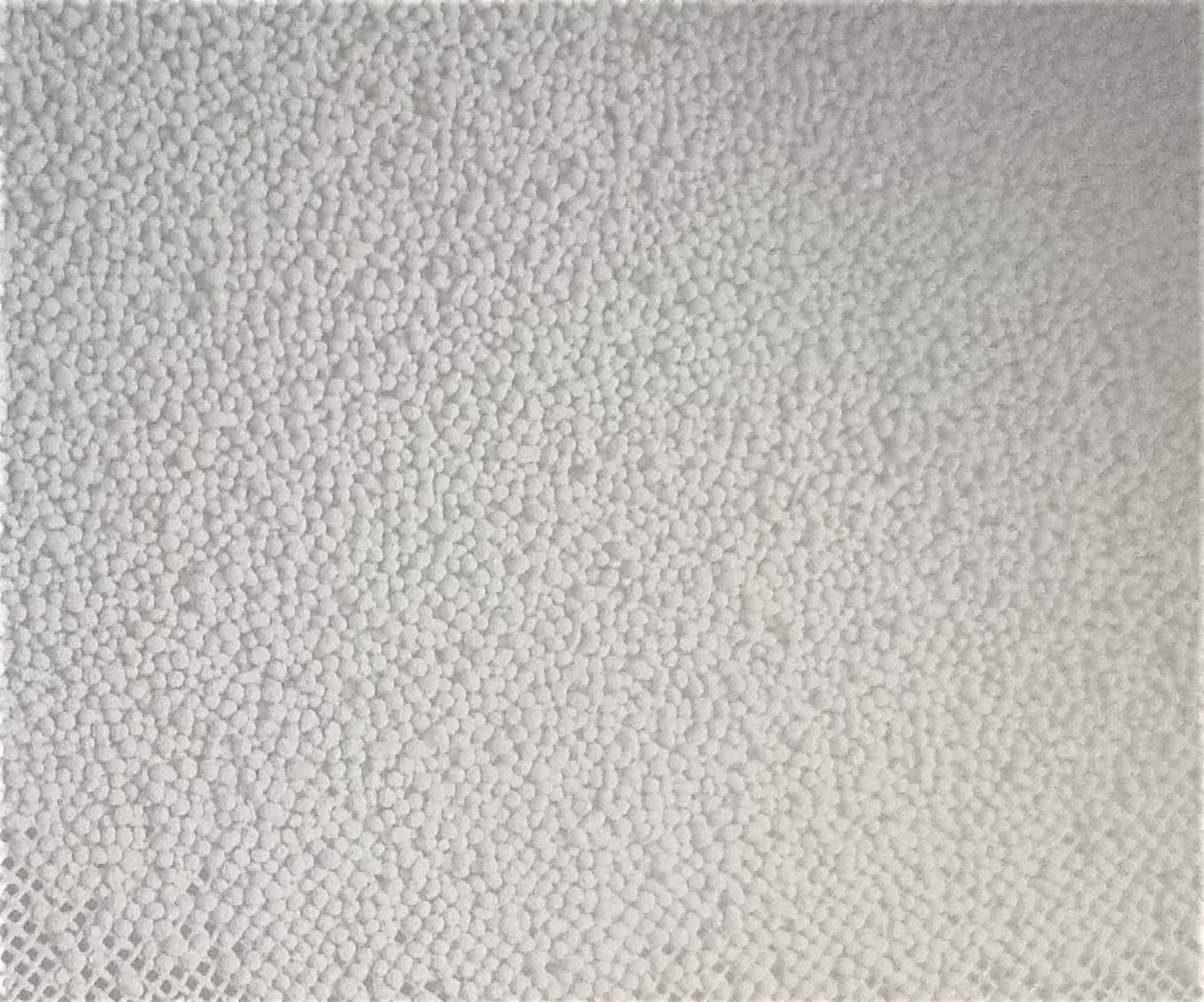
Figure 1: Sieved pebbles with diameters of 1mm to 1.6mm consisting of a mixture of dust and water ice with a ratio 3:1.
The materials are mixed and then shaken while low temperatures are secured. For a homogenous mixture some nitrogen is added during the mixing procedure. In order to be able to form the largest possible number of pebbles from a mixture, it is necessary to understand the process of pebble formation. Therefore, we have studied the formation behaviour of pebbles from mixtures with different mixing ratios and by using different shaking techniques. Recent experiments have shown that mixtures with different weight ratios of dust-to-water ice can form pebbles. Also, adding a certain amount of graphite to darken the mixture has no effect on the formation process.
To study and to quantify the properties of the pebbles, such as compressive strength and thawing behaviour, it is important to know the particle size distribution. For this purpose, the pebbles must be sieved. This has been successfully carried out at the TU Braunschweig. With the samples obtained in this way, it has already been possible to gain initial insights into, among other things, the thawing behaviour and porosity of the pebbles. It was found, for example, that pebbles with an higher dust content retain their structure and a baking effect occurs, which leads to a hardening of the material, whereas pebbles with a low dust content collapse.
During this conference we will present our pebble making technique and our findings about the formation of pebbles. Further, we want to introduce the audience to our shaking machine. The latest results about the thawing behaviour as well as other properties of the pebbles will be presented, too.
How to cite: Brecher, N., Kreuzig, C., Gundlach, B., and Blum, J.: The Production of Dust-Ice-Pebbles, Europlanet Science Congress 2022, Granada, Spain, 18–23 Sep 2022, EPSC2022-526, https://doi.org/10.5194/epsc2022-526, 2022.
Sublimation of volatile materials causes a pressure build-up in the surface layers of comets, which then leads to outgassing and to the ejection of particles. To investigate this behavior in more detail, an experimental setup was developed as part of the CoPhyLab campaign [1]. With this setup different comet analogue samples are exposed to an artificial Sun to simulate cometary activity. The first experiments are conducted with pure water ice samples only since water ice comprises the bulk of volatile materials in most comets [2] and pure samples provide a well comprehensible starting point to model the development of the experiments.
Thanks to our experiments we were able to observe, for the first time, that the sublimation of pure water ice (ice without any additional components, or impurities) can eject solid grains. Hence, the ejection of water ice grains does not require the presence of a more volatile species as suggested by [3]. In our experiments, the trajectories of the grains were recorded with a high-speed camera and subsequently evaluated with respect to their motion behavior using a particle tracking routine (Fig. 1).

Fig.1: Superimposed image of all “well-tracked” particle trajectories of one experiment over the observed sample surface.
The ejected particles possess terminal speeds of about 1 m/s. Further, we found that the terminal particle velocity, as well as the total activity, depends directly on the insolation. Moreover, the observed trajectories were modeled by using gas-drag laws to derive an estimate for the sublimation pressure inside the samples [4].
The knowledge gained from these experiments will be used both in a larger experimental setup [5] and in further experiments including mixtures of water ice with dust and with super-volatiles such as CO2.
References
[1] Gundlach, B., “CoPhyLab: recent and future experiments - an overview”, 2020. doi:10.5194/epsc2020-218.
[2] Bockelée-Morvan, D., “An Overview of Comet Composition”, in The Molecular Universe, 2011, vol. 280, pp. 261–274. doi:10.1017/S1743921311025038.
[3] A'Hearn, M. F., “EPOXI at Comet Hartley 2”, Science, vol. 332, no. 6036, p. 1396, 2011. doi:10.1126/science.1204054.
[4] Capelo, H. L., “Observation of aerodynamic instability in the flow of a particle stream in a dilute gas”, Astronomy and Astrophysics, vol. 622, 2019. doi:10.1051/0004-6361/201833702.
[5] Kreuzig, C., “The CoPhyLab comet-simulation chamber”, Review of Scientific Instruments, vol. 92, no. 11, 2021. doi:10.1063/5.0057030.
How to cite: Molinski, N., Kreuzig, C., Blum, J., Capelo, H., Pommerol, A., and Gundlach, B.: Particle tracking analysis of ejected water-ice grains from pure ice cometary analogue samples, Europlanet Science Congress 2022, Granada, Spain, 18–23 Sep 2022, EPSC2022-383, https://doi.org/10.5194/epsc2022-383, 2022.
In the previous years, the CoPhyLab* has established an experimental environment that makes it possible to simulate the activity of comets in the best way possible. Nevertheless, it is vital to know all parameters that have an impact on the outcome of such experiments, as well as parallelly developed models. Therefore, several smaller experiments provide important knowledge, especially about the used comet analogue, the CoPhyLab-dust.
With the gas-flow experiment we conduct in Graz it is possible to learn about the permeability and effusion of gas through porous media in a dry environment. In this presentation we will present how that works and what challenges we needed to overcome to achieve good scientific outcomes.
With the results of this experiment a special case of the dusty-gas model, established by Evans et al. 1961 [1], will be tested in high vacuum.
A vacuum chamber with two compartments, which are connected via a tube that holds the tested sample, is used for the experiment (see Figure 1). In both compartments pressure sensors are mounted onto the chamber. For our measurements we use two different gas-flow controllers with different gas-flow ranges to cover a wide pressure range. As this is a continuing work, the theoretical scheme was established by Schweighart et al. 2021 [2]. According to Equation 10 from their work, knowledge of the upstream and downstream pressure as well as the mass flux flowing through the sample, allows us to measure the Knudsen diffusion Dk as well as the permeability B of the sample.
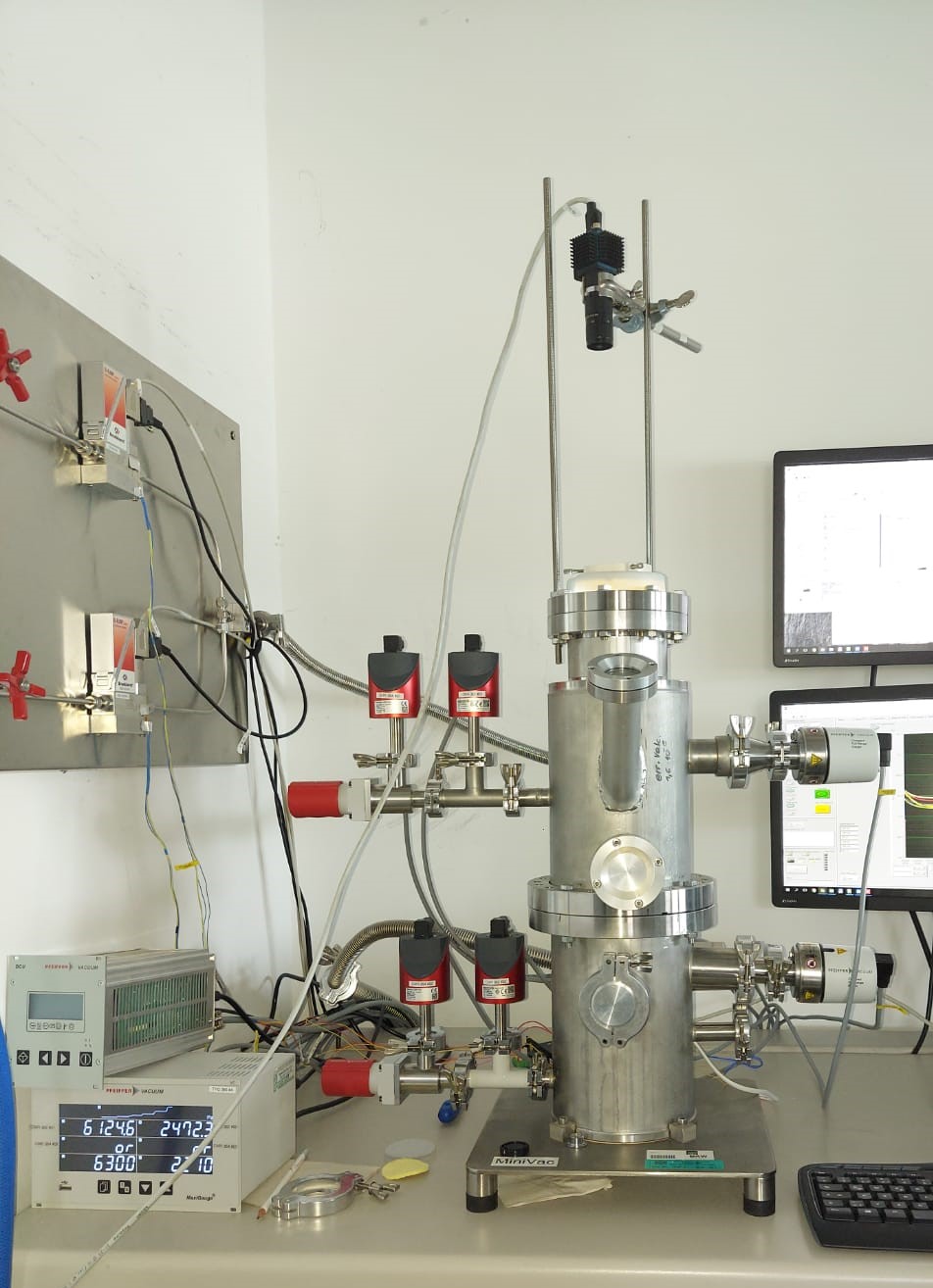
Figure 1: Experiment Setup
Because gas-flow must be known precisely, a leakage of gas into the chamber, which is always there could have an influence on the evaluation of the results. Therefore, a bleed-up test was performed. To work with porous media is a difficult task. Therefore, measurements with round glass beads, with a predictable packing behavior, were performed.
We found that the results deviate from the regression using the dusty gas model at lower pressures or smaller gas flows (see Figure 2). There is a systematic decrease in pressure at smallest gas flows. We are currently investigating the possible causes for this behavior.
On the one hand, we consider if the deviation could be explained by set up related properties, like a leak in the chamber or a systematic offset on the gas flow. On the other hand, an outgassing of volatiles or a temperature dependence are possibilities we are looking into. Nevertheless, we already gain high confidence results in the measured pressure regime. In future we will investigate how those results compare to theoretical models, which consider the porosity and the tortuosity of such porous samples (e.g., Asaeda et al. 1974 [3]).
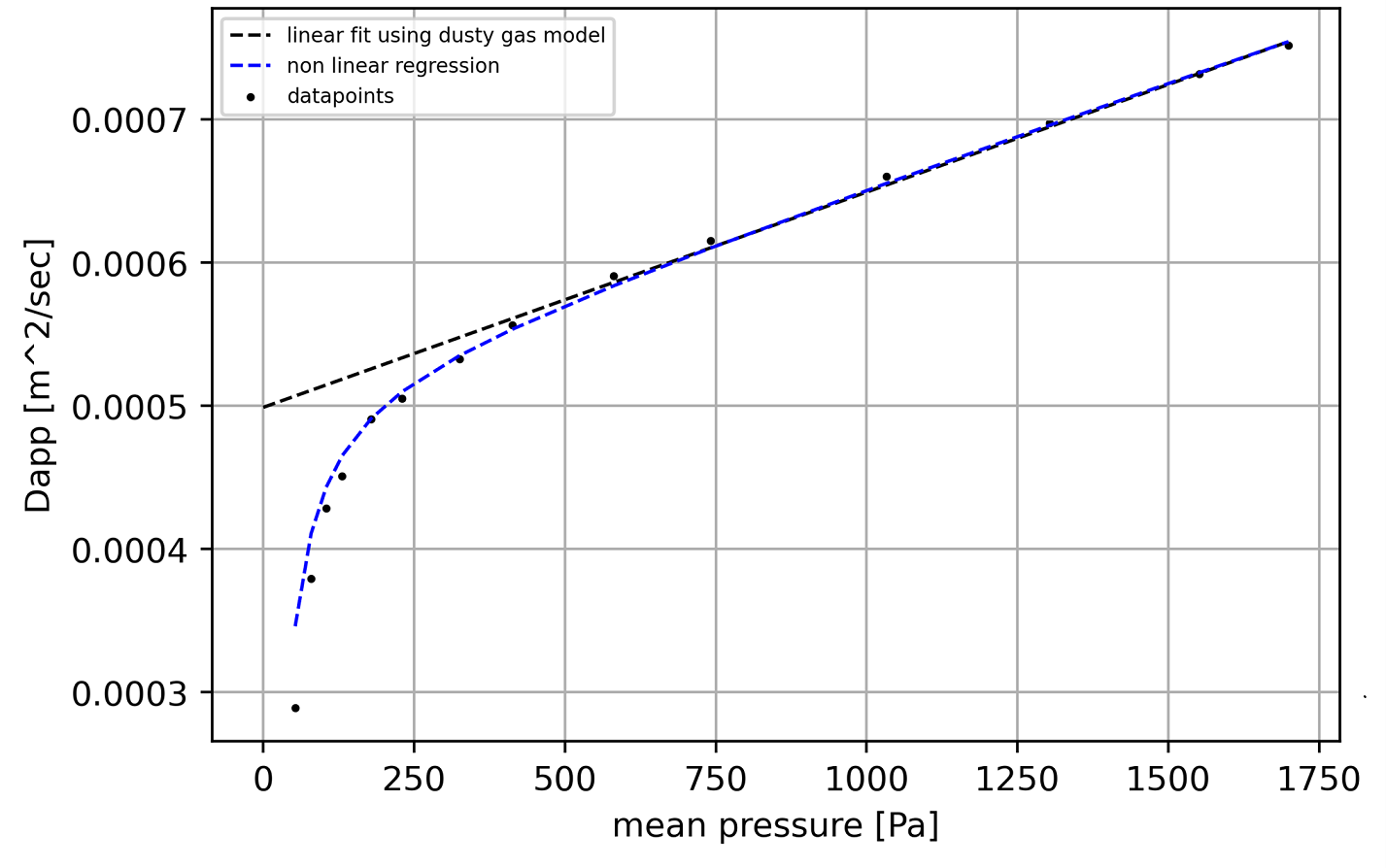
Figure 2: Experimental results for an asteroid analogue sample,
with the apparent Diffusion Dapp depending on the mean pressure within the tested sample.
Acknowledgements:
This work is carried out in the framework of the CoPhyLab project funded by the D-A-CH programme (DFG GU 1620/3-1 and BL 298/26-1 / SNF 200021E 177964 / FWF I 3730-N36).
References:
[1] Evans III, R. B., G. M. Watson, and E. A. Mason. "Gaseous diffusion in porous media at uniform pressure." The journal of chemical physics 35.6 (1961): 2076-2083.
[2] Schweighart, M., et al. "Viscous and Knudsen gas flow through dry porous cometary analogue material." Monthly Notices of the Royal Astronomical Society 504.4 (2021): 5513-5527.
[3] Asaeda, Masashi, Shigeyuki Yoneda, and Ryozo Toei. "Flow of rarefied gases through packed beds of particles." Journal of Chemical Engineering of Japan 7.2 (1974): 93-98.
*The CoPhyLab (Comet Physics Laboratory): https://www.cophylab.space/index.php?id=home
How to cite: Zivithal, S., Kargl, G., Macher, W., Laddha, S., Güttler, C., Sierks, H., Blum, J., and Gundlach, B. and the CoPhyLab-Team: Experimental Characterization of Gas Flow Properties of Dry Refractory Materials, Europlanet Science Congress 2022, Granada, Spain, 18–23 Sep 2022, EPSC2022-930, https://doi.org/10.5194/epsc2022-930, 2022.
Please decide on your access
Please use the buttons below to download the presentation materials or to visit the external website where the presentation is linked. Regarding the external link, please note that Copernicus Meetings cannot accept any liability for the content and the website you will visit.
Forward to presentation link
You are going to open an external link to the presentation as indicated by the authors. Copernicus Meetings cannot accept any liability for the content and the website you will visit.
We are sorry, but presentations are only available for users who registered for the conference. Thank you.
Posters: Thu, 22 Sep, 18:45–20:15 | Poster area Level 2
Introduction
Astrophysical ices were observed in various environments with different compositions : from the icy grains of the interstellar medium (ISM, [1]), to various bodies of the solar system such in icy moons of Jupiter or Saturn systems, or in comets. In such environments, ice is subjected to various alterations ranging from a wide range of UV doses, different physicochemical alterations [2], thermal alterations [3] and various primitive ice composition [4]. As inferred by laboratory experiments, these ice alterations are now known to generate a large molecular diversity ( [5], [6]). This organic matter is well observed in certain meteorites where up to 4 % of the total matter is organic (carbonaceous chondrites [7]), but this number can grow up to 45 % in interstellar dust particles and comets [8]. Laboratory experiments suggest that grain chemistry from primitive ices composed of H2O, NH3, methanol (MeOH) or other molecules is the main source of this astrophysical organic matter ([9], [10]). The reactivity occurring during the alteration of such an ice is a two step mechanism: First, energetic processes form radicals such as H•CO or •CH2OH which directly produces molecules such as CO or CO2 [14]; Then, thermal reactivity can occur to form more complex organic compounds. During this second phase, radicals diffuse, which allows their recombination forming more complex molecules such as hexamethylenetetramine (HMT), polyethyleneimine (PMI) or polyoxymethylene (POM) [15].
The refractory [16] and volatile [17] compositions of the final organic pool is thus highly influenced by the initial ice composition ratio. In the present work, we investigate the influence of the heating rate, the residual pressure or of the photon/molecule ratio on this final organics.
Method
All the experiments were monitored in the MICMOC experiment already described in [11]. It is a cryogenic vacuum chamber (~10-7 mbar) with a finger cooled down up to 77 K using liquid nitrogen. The cold finger contains IR transparent MgF2 windows on which primitive moieties H2O, NH3 and methanol (MeOH) are deposited within a fixed 3:1:2 ratio (H2O:MeOH:NH3). The irradiation at Lyman α (121 nm) is concomitant to the ice formation during 70 h and then warmed up to ~300 K. The following experiments were performed :
- Various irradiation rates (1,5.103, 141, 5 photon/MeOH), by modifying the flux of matter;
- Fixed irradiation (~80 photon/MeOH) and various heating rates (0.5, 4, 8 K/min) monitored by a heating resistance after the irradiation phase;
- Fixed irradiation and various pressures of Ar added during the heating phase.
All samples were then analyzed using both fourier-transform infrared spectrometry (FT-IR) and electrospray fourier- transform ion cyclotron resonance mass spectrometry (ESI-FT-ICR [18]).
Preliminary results and conclusions
Preliminary results are displayed Figure 1. First, infrared spectroscopy measurements show weak impacts of heating rate and residual pressure during the warming phase: The main IR features present similar intensities implying no significant evolution of the final organic products. The only significant influence observed is the lower FT-IR intensity recorded at lower heating rate (0.5 K/min). Regarding the irradiation rate, it shows the highest evolution on the IR signatures : for low irradiation rates (5 photon/MeOH) ν(OH) at 3242 cm-1 vs νas(CH) at 2923 cm-1 ratio is significatively modified and ω(CH2) at 1458 cm-1 and νas(COO-) at 1598 cm-1 are significatively exhausted. This suggests the presence of salts, polyoxymethylene (POM), hexamethylenetetramine (HMT) and polyethyleneimine (PMI) in higher quantities in this sample. On the contrary, the FT-IR spectrum of the higher irradiated sample shows no features because of a decrease in the yield of organic production implying a lack of sensitivity with FT-IR.
To obtain complementary information on the molecular evolution ESI-FT-ICR analysis was recorded on the same samples. The ESI-FT-ICR confirmed the preliminary results observed with FT-IR with a better insight on the molecular processes impacting the final organic composition. All together the influence of those three parameters are the following :
- Irradiation has a high impact on the molecular content of the sample, mostly on the DBE, but also on the molecular diversity and abundance;
- The increase of the residual pressure during the heating phase has a weak influence, even if it increases a higher experimental dispersion regarding the molecular abundance while the molecular diversity is not impacted;
- Finally, the heating rate has a very weak influence on the final organic composition.
Figure 1 Comparison of FT-IR spectra or ESI+ FT-ICR mass spectra of the residue for each sample series (A, B, C). Global shape of both ESI+ and ESI– of FT-ICR analysis are showing similar properties.
Bibliography :
[1] D. H. Wooden et al., “Composition and Evolution of Interstellar Clouds,” in Comets II, University of Arizona Press, pp. 33–66, 2004.
[2] G. M. Muñoz Caro et al., ACS Earth Space Chem, vol. 3, no. 10, pp. 2138–2157, 2019.
[3] O. Mousis et al., Astrophys. J., vol. 819, no. 2, p. L33, 2016.
[4] M. J. Mumma and S. B. Charnley, Annu. Rev. Astron. Astrophys., vol. 49, no. 1, pp. 471–524, 2011.
[5] G. Danger et al., GCA, vol. 118, pp. 184–201, 2013.
[6] A. Ruf et al., Life, vol. 9, no. 2, p. 35, 2019.
[7] S. Pizzarello and E. Shock, Cold Spring Harb. Perspect. Biol., vol. 2, no. 3, pp. a002105–a002105, 2010.
[8] J.-L. Bertaux and R. Lallement, MNRAS, vol. 469, no. Suppl_2, pp. S646–S660, 2017.
[9] A. Gutiérrez-Quintanilla et al., MNRAS, vol. 506, no. 3, pp. 3734–3750, 2021.
[10] G. Fedoseev et al., MNRAS, vol. 448, no. 2, pp. 1288–1297, 2015.
[11] L. d’Hendecourt and E. Dartois, Spectrochim. Acta A Mol. Biomol. Spectrosc., vol. 57, no. 4, pp. 669–684, Mar. 2001.
[12] P. Schmitt-Kopplin et al., PNAS, vol. 107, no. 7, pp. 2763–2768, 2010.
[13] F. Duvernay et al., ApJ, vol. 791, no. 2, p. 75, 2014.
[14] K. I. Öberg, Chem. Rev., vol. 116, no. 17, pp. 9631–9663, 2016.
[15] V. Vinogradoff et al., A&A, vol. 551, p. A128, 2013.
[16] A. Fresneau et al., ApJ, vol. 837, no. 2, p. 168, 2017.
[17] N. Abou Mrad et al., ApJ, vol. 846, no. 2, p. 124, 2017.
[18] P. Schmitt-Kopplin et al., Anal. Chem., vol. 82, no. 19, pp. 8017–8026, 2010.
How to cite: Javelle, T., Ruf, A., Schmitt-Kopplin, P., and Danger, G.: Impacts of residual pressure, heating rate and photon to molecular ratio on the molecular composition generated by the processing of astrophysical ices, Europlanet Science Congress 2022, Granada, Spain, 18–23 Sep 2022, EPSC2022-102, https://doi.org/10.5194/epsc2022-102, 2022.
Micro- and nano-scale computed tomography (µ-CT, n-CT) is a relatively fast method for studying, among others, textural and physical properties of solid materials. For example, we are using micro- and nano-CT techniques to study chondrules and CAIs from primitive meteorites. If properly calibrated, CT studies can also help obtaining (qualitative) chemical information. However, there was always the question whether or not CT-techniques are non-destructive. We tested for this by using matrix material from the CV3 chondrite Allende. We prepared a powdered matrix sample and divided them into five aliquots; three aliquots were irradiated using a Bruker SkyScan 1272 µXCT-Scanner, at the Anatomy department at the university of Bern, operating at 70 keV, 50 keV, or 30 keV. Two samples served as non-irradiated standards. We investigated if the irradiation has any effect on the noble gas concentrations. We found that that there is no effect, i.e., the noble gas concentrations are indistinguishable between irradiated and non-irradiated samples. Since there is no effect for the very fine-grained matrix material, we can conclude that there is also no effect for larger objects like chondrules and CAIs.
How to cite: Ghaznavi, P., Kadlag, Y., Leya, I., and Haberthuer, D.: The effects of irradiation on the noble gases in matrix of Allende (CV) meteorite, Europlanet Science Congress 2022, Granada, Spain, 18–23 Sep 2022, EPSC2022-115, https://doi.org/10.5194/epsc2022-115, 2022.
Introduction
Carbonaceous chondrites (CCs) are fragments of primitive asteroids that are known to contain up to 6 wt.% of organic matter (OM). The insoluble organic matter (IOM) represents 75 to 95 wt.% of the total recovered organic matter. It is therefore the major organic carbon component of CCs. Its Analyses revealed that the IOM is constituted of aromatic units with aliphatic structures bridging aromatic units. Heteroatoms also compose the IOM with mostly oxygen next to nitrogen and sulfur. As a result, the IOM is schematically represented as a cross-linked structure of aromatic and aliphatic units with some heteroatoms, constituting macromolecules. Here, we used a new analytical method to analyse an IOM fraction of Paris meteorite: Laser desorption ionization (LDI) coupled to an ultra-high-resolution mass spectrometer (FT-ICR-MS) on a Paris IOM, which demonstrate that an important molecular diversity with low masses also forms IOM of meteorites.
Results
The coupling of LDI with a high-resolution mass spectrometer allows obtaining information on the molecular diversity present in this IOM. We indeed reveal new and original information on the molecular composition, diversity and aromaticity of the Paris IOM that can be related to synthesis environments during the early ages of the solar system.
- An unprecedented molecular diversity is observed with a wide range of molecular family.
- Molecules observed present low masses with a high aromaticity and the presence of low amounts of heteroatom such as N, O and S.
- The molecular cores are based on aromatic rings with various aliphatic branching depending on the molecular family.
- Pure PAH are also observed, and fullerenes are observed at higher laser energy, suggesting a formation from high PAH structures that could correspond to a part of the IOM macromolecular structure.
Acknowledgements
We are grateful to the meteorite collection of the Muséum National d’Histoire Naturelle in Paris for providing the sample of the Paris meteorite.
N.C. and L.R. thank the European Research Council for funding via the ERC projects PrimChem (grant agreement No. 636829) and HYDROMA (grant agreement No. 819587). This work was supported by the European Regional Development Fund (ERDF) No. HN0001343, the European Union’s Horizon 2020 Research Infrastructures program (Grant Agreement 731077), the Région Normandie, and the Laboratoire d’Excellence (LabEx) SynOrg (ANR-11-LABX-0029). Access to a CNRS FTICR research infrastructure (FR3624) is gratefully acknowledged. G.D., A.R., and L.R. thank the Agence nationale de la recherche (RAHIIA_SSOM, ANR-16-CE29-0015), the Centre National d’Etudes Spatiales from its exobiology program, and the Centre National de la Recherche Française (CNRS, “Physique et Chimie du Milieu Interstellaire” (PCMI) and “Programme National de Planétologie” (PNP) programs) for their financial support..
References
[1] Unprecedented molecular diversity revealed in meteoritic insoluble organic matter : The Paris meteorite’s case. G. Danger*, A. Ruf, J. Maillard, J. Hertzog, V. Vinogradoff, P. Schmitt-Kopplin, C. Afonso, N. Carrasco, I. Schmitz-Afonso, L. Le Sergeant d’Hendecourt, Laurent Remusat. Planetary Science Journal, 2020, 1, 55.
How to cite: Danger, G., Ruf, A., Maillard, J., Vinogradoff, V., Schmitt-Kopplin, P., Afonso, C., Schmitz-Afonso, I., and Remusat, L.: What if the insoluble organic matter of meteorites showed unexpected molecular diversity?, Europlanet Science Congress 2022, Granada, Spain, 18–23 Sep 2022, EPSC2022-284, https://doi.org/10.5194/epsc2022-284, 2022.
Reflectance spectroscopy remains the most important tool to remotely infer mineralogical and chemical information of Earth and planetary surfaces (Bishop at al. 2019). Meteorites represent a sampling of planetary bodies with variable differentiation degree, mineralogy, and chemistry. For this reason, an accurate laboratory characterization of meteorites is of crucial importance for the correct understanding of spectral features of planetary bodies. This is especially true for the VNIR spectral range (~ 0.3-2.5 µm) where most of the spacecraft instruments operate and earth-based telescopes work. On the other hand, IR spectroscopy is of paramount importance to detect subtle chemical and mineralogical variations in minerals and rocks. Here we report a spectroscopic and mineralogical characterization of a suite of ungrouped achondrites which do not fit any classification scheme and their origin, in terms of planetary bodies, is either unknown or highly uncertain. We acquired reflectance spectra in both VNIR (0.35-2.5 µm and IR (~600 to ~7000 cm-1 or ~2 – ~17 µm) spectral ranges. The spectroscopic characterization has been performed with a spatial resolution spanning two orders of magnitude (from ~ 5·10-5 to ~ 5·10-3 m) allowing us to relate the bulk spectroscopic response of the rocks with the spectroscopic features of their constituent minerals. Bidirectional reflectance (VNIR and bulk FTIR) measurements were performed at IAPS-INAF, µ-FTIR measurements were executed at DAFNE-Light synchrotron radiation facility at LNF – INFN, while EPMA and SEM analysis were performed at MEMA – Department of Earth Sciences of Florence. Our results show a wide chemical and mineralogical variation between the samples. The mineralogical and chemical variation is clearly reflected on spectroscopic features. In Fig 1 we report the MidIR reflectance spectra and SEM-EDS images for sample NWA 5400. Fig. 1a shows the bidirectional reflectance spectrum for the powders (spot size: 6 mm). Fig. 1b we report the SEM-EDS image of a small area of the sample with the detected phases indicated by different colors. In Fig. 1c we show the µ-FTIR results on the same area in (b). It is interesting to note how the µ-FTIR spectra of olivine are slightly different in term of band position and area likely indicating small chemical heterogeneities within the sample.
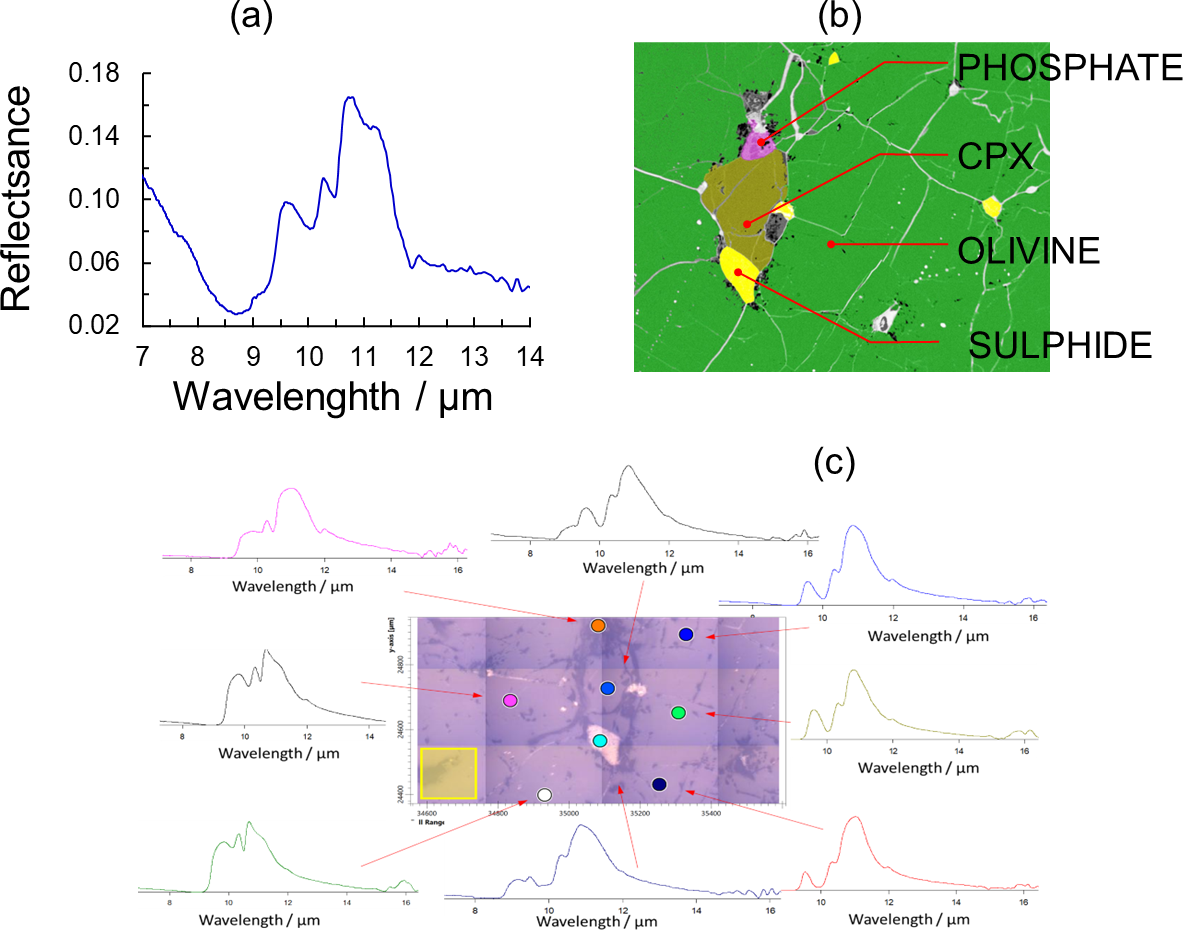
Figure 1. FTIR/SEM-EDS results for sample NWA 5400. (a) Bidirectional FTIR reflectance spectrum on powdered sample [spot size: 6 mm]. (b) SEM-EDS (false colors) of a small area (1 x 0.6 mm) of the sample. The different colors correspond to the detected mineral phases. (c) µ-FTIR spectra collected in the same area showed in (b). Location of the spot analysis is marked by colored dots. Yellow area corresponds to the spatial resolution of the µ-FTIR analysis (150 x 150 µm) in this sample.
Fig. 2(a) shows representative VNIR spectrum for high-pyroxene content meteorites like NWA 6704. Figure 2(b) shows a representative VNIR spectrum for medium-high content olivine samples like NWA 10503. The spectral features are highly dependent from modal abundances of mafic minerals (mainly olivine and pyroxene) so that it is possible to identify two main groups: olivine-dominant achondrites and pyroxene-dominant achondrites. Cloutis et al. (1986) proposed a plot to show the relationship between spectral features and olivine/pyroxenes content. The same plot was later considered by Gaffey et al. (1993) to discriminate the S-type asteroids on the basis of the band I center and the ratio between the area of band I and band II (BAR). Recently this relationship has been also used to relate spectral variation of achondrites and possible parental bodies (e.g. Carli et al. 2018; Lucas et al 2019) and is reported in Fig 3 for our samples.
Figure 2. Typical VNIR reflectance spectra for pyroxene-dominant achondrites (a) and olivine-dominant achondrites (b)
Reflectance spectroscopy coupled with a thorough mineralogical and geochemical investigation of meteorites proved to be a powerful technique to infer quantitative conclusions about their origin, history and associate them with their provenance. Using the plot originally proposed by Gaffey et al. (1993) we clustered our samples in four distinct regions which likely correspond to potentially four different family of small objects. µ-FTIR was instead successfully applied to retrieve small-scale information including mapping the chemical and mineralogical heterogeneities. Acknowledgments: This research was supported by ASI-INAF n.2018-16-HH.0 (Ol-BODIES project)
Figure 3. B I center vs BAR (from Gaffey et al. 1993) plot for the investigated samples
REFERENCES
Bishop, J. L., Bell III, J. F., Bell, J., & Moersch, J. E. (Eds.). (2019). Remote Compositional Analysis: Techniques for Understanding Spectroscopy, Mineralogy, and Geochemistry of Planetary Surfaces (Vol. 24). Cambridge University Press.
Cloutis, E. A., Gaffey, M. J., Jackowski, T. L., & Reed, K. L. (1986). Calibrations of phase abundance, composition, and particle size distribution for olivine‐orthopyroxene mixtures from reflectance spectra. Journal of Geophysical Research: Solid Earth, 91(B11), 11641-11653.
Gaffey, M. J., Bell, J. F., Brown, R. H., Burbine, T. H., Piatek, J. L., Reed, K. L., & Chaky, D. A. (1993). Mineralogical variations within the S-type asteroid class. Icarus, 106(2), 573-602.
Lucas, M. P., Emery, J. P., Hiroi, T., & McSween, H. Y. (2019). Spectral properties and mineral compositions of acapulcoite–lodranite clan meteorites: Establishing S‐type asteroid–meteorite connections. Meteoritics & Planetary Science, 54(1), 157-180.
Carli, C., Pratesi, G., Moggi‐Cecchi, V., Zambon, F., Capaccioni, F., & Santoro, S. (2018). Northwest Africa 6232: Visible–near infrared reflectance spectra variability of an olivine diogenite. Meteoritics & Planetary Science, 53(10), 2228-2242.
How to cite: Bruschini, E., Carli, C., Romani, M., Cuppone, T., Cestelli Guidi, M., Viviani, G., and Pratesi, G.: Multiscale spectroscopic characterization of ungrouped achondrites, Europlanet Science Congress 2022, Granada, Spain, 18–23 Sep 2022, EPSC2022-349, https://doi.org/10.5194/epsc2022-349, 2022.
Introduction: The comprehension and interpretation of VIS-IR spectra from space missions to Solar System rocky bodies is generally based on the qualitative/quantitative comparison with standard laboratory datasets [1,2,3,4], i.e. spectra often acquired in laboratory at room pressure/temperature, so dominated by water bands [5]. We developed the new laboratory setup CAPSULA (Chamber for Analogues of Planetary Surfaces Laboratory), consisting of an environmental chamber equipped with a FTIR spectrometer to acquire spectra of planetary analogues in various conditions. The chamber allows to obtain (i) high vacuum (<10-6 mb); (ii) high (>1000K) and cryogenic T (<80K). With this setup planetary analogues of terrestrial planets surfaces as well as of icy moons and meteorites can be studied in a wide spectral range and in different environmental conditions. The opportunity of recording spectra on analogs and meteorites in the lab at conditions similar to extra-terrestrial environments is key to improving our interpretation of spectra acquired remotely from orbital and landed missions at remote sites in our Solar System.
Setup description: The CAPSULA setup is hosted at INAF-IAPS C-Lab laboratory (fig.1). It is constituted by (i) a Bruker Fourier Transform Infrared (FTIR) spectrometer, equipped with an MCT and DLaTGS detectors and (ii) a large high vacuum chamber 50x60 cm, in which the samples to be analyzed are placed. The chamber and the spectrometer are coupled by means of optical fiber bundles, each composed by seven 200/260-mm core/cladding fibers. Although the FTIR detectors are sensitive up to 20 µm, currently the fibers, in Indium Fluoride Glass, allow the signal to be transmitted in the 0.35-5.5 µm range. The illumination spot on the sample (at angle of 30°) and the collection spot (at 0°) are <1 mm. Several samples (up to 15) can be simultaneously processed in high vacuum in order to be analyzed by means of reflectance spectroscopy in the VIS-IR range. A heating system consisting of five rectangular Si3N4 heaters, placed just below copper sampleholders cups, allows to heat samples up to 1073K in high vacuum. A liquid He compressor connected to a cold head within the chamber permits to cool down the samples at cryogenic temperatures below 80K.
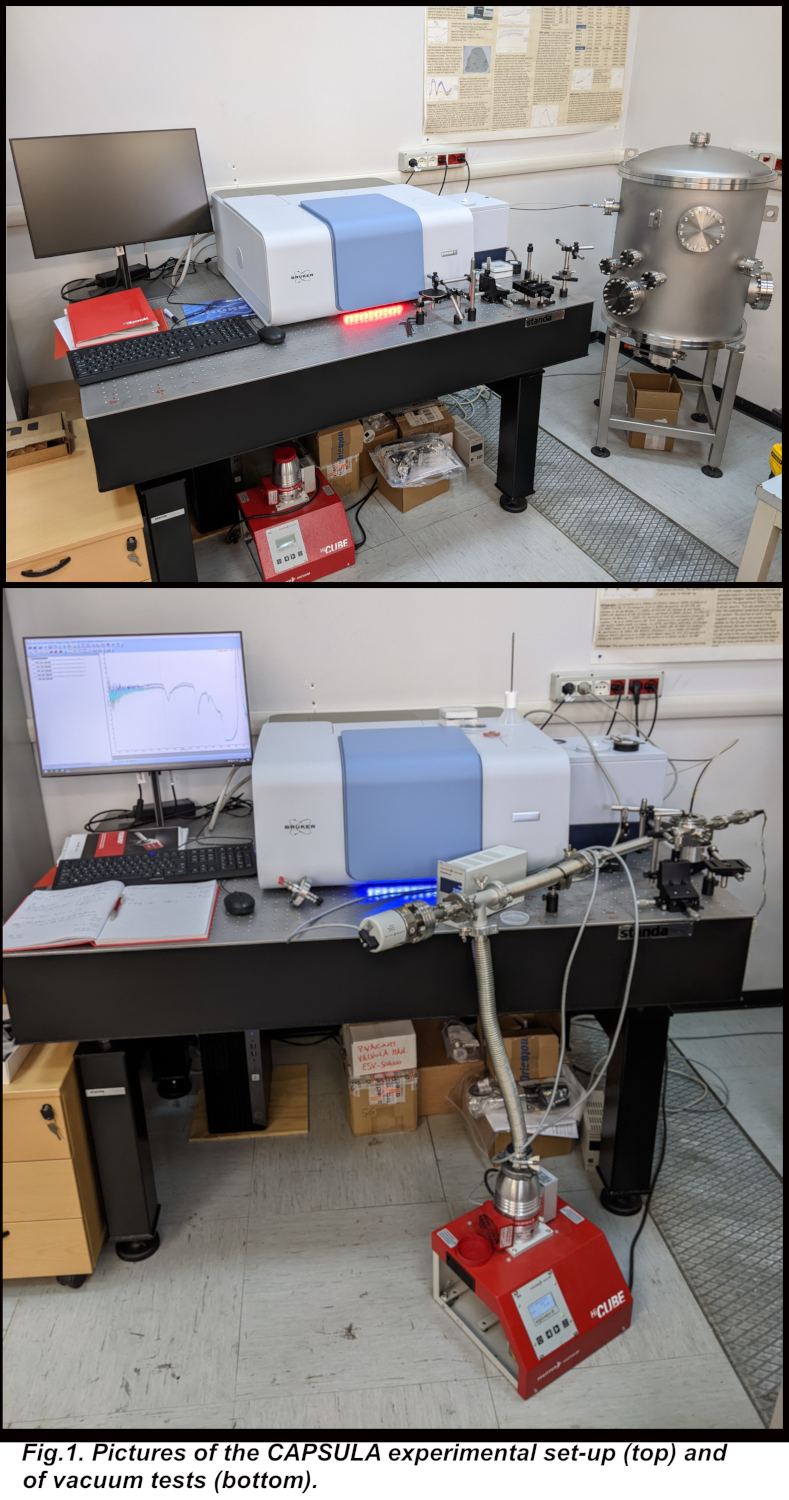
Preliminary tests and measurements: As preliminary activity the optical fibers have been extensively characterized in the laboratory in terms of spectral transmission, in the 0.35-5.5-µm range, resulting in an average transmission of at least 80% for each fiber.
With the aim of starting to test the setup, preliminary spectral measurements have been performed on a powder sample of ammoniated montmorillonite (NH4-SCa3) [6,7] (fig.2). The sample, in the form of <100-µm powder, has been preliminarly analyzed in the 1-5 µm range. This spectral range is currently defined by the optical fibers transmission (0.35-5.5 µm) convolved with MCT detector cut-on wavelength (>1 µm) and NIR source spectrum cut-off (<5 µm). A Labsphere Infragold has been used as reference target. Reflectance spectra have been acquired in vacuum at room temperature (18°C), with pressure variable from ambient (103 mbar), then at 5, 4, 3 mbar and down to 10-6 mbar. Each spectrum (both reference and sample) is acquired by doing 512 scans with the FTIR interferometer, which takes about 2’. During this time the pressure changed very slowly, i.e. by less than 5%. It can be seen how dehydration proceeds during the pumping, as seen by the decrease of H2O bands at 1.5, 2 and 3 µm. Correspondingly absorption features due to NH4+ become clearly visible (1.55, 2.1-2.2, 3.1 and 3.25 µm) (fig.3).
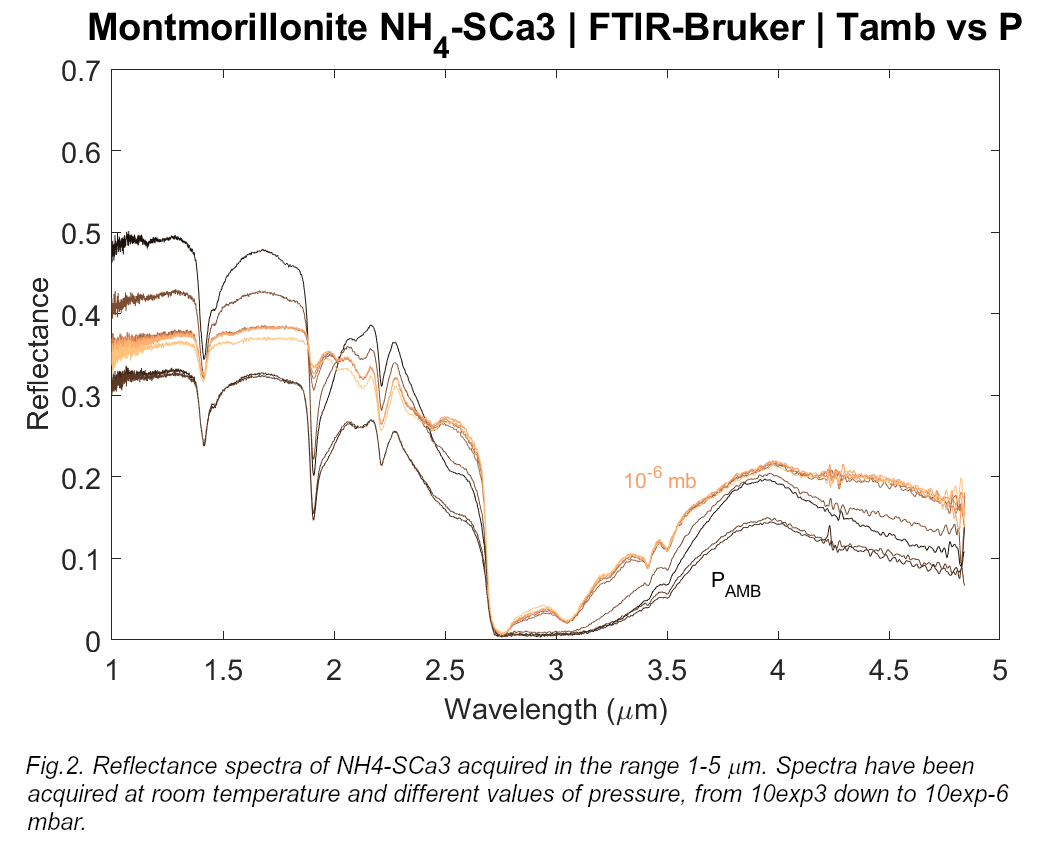
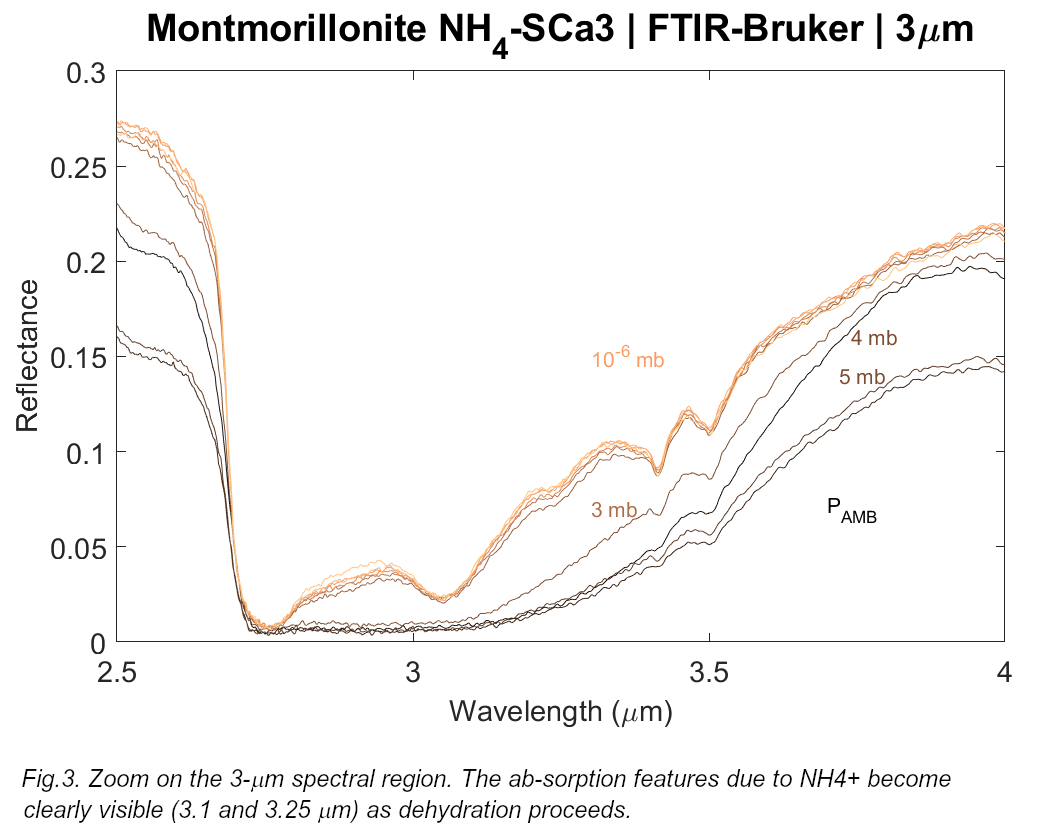
Future work:
We are currently testing the different subsystems of the setup (cooling/heating system) and working on several upgrades of the experimental system, including the extension of the spectral range in the mid-IR (above 5 µm) through the use of mirrors. We are in parallel starting to carry out scientific measurements on analogues of different planetary rocky objects (Mars, Ceres) with the current setup.
References: [1] De Sanctis M.C. et al. (2015), Nature Letter 528, 241-244. [2] Elkins-Tanton L.T., et al.: (2016) XLVII LPSC, abstract #1631. [3] Hamilton V.E., et al. (2019) Nature Astronomy. [4] Kitazato K., et al. (2019), Science, 364, 272-275. [5] Beck P., et al. (2018) Icarus 313, 124–138. [6] Ferrari M., et al. (2019) Icarus. [7] De Angelis S., et al. (2021), JGR:Planets, V.126, Is.5, e2020JE006696.
Acknowledgements: The CAPSULA project has been funded in the framework of ASI-INAF Announcement of Opportunity in 2018 for Solar System studies, with a two years grant. We acknowledge financial contribution from the Agreement ASI-INAF n.2018-16-HH.0.
How to cite: De Angelis, S., La Francesca, E., Ferrari, M., De Sanctis, M. C., De Astis, G., Casalini, M., Pratesi, G., Moggi Cecchi, V., Agrosì, G., Tempesta, G., Manzari, P., Frigeri, A., and Di Iorio, T.: The CAPSULA Project: a laboratory for planetary analogues, Europlanet Science Congress 2022, Granada, Spain, 18–23 Sep 2022, EPSC2022-540, https://doi.org/10.5194/epsc2022-540, 2022.
- Introduction
The characterization of the complex magnetic susceptibility (real and imaginary parts) of rocks is an unexplored tool to constrain the composition, structure and geological history of rocks in surface planetary exploration. We propose the NEWTON susceptometer for the determination of the complex magnetic susceptibility, to provide valuable information about the regolith and surface rocks in rocky bodies of the solar system, to be used as a selection criterion of rocks for sample return missions or for the in-situ scientific studies of the magnetic properties during planetary missions [1]. The instrument is based on AC - inductive methods, and its dynamic range of the real susceptibility covers magnetic susceptibility values for rocks from the Earth, Moon and Mars [2, 3, 4]. The sensor is suitable to be placed on board rovers, or to be used as a portable device during field campaigns and by astronauts in manned space missions. This sensor provides a great advantage compared to available commercial susceptometers due to its robustness, compatibility with the planetary environments and that it does not require sample preparation, but only minimum sample dimensions (~50 x 20 x 20 mm).
The aim of this work is to test the capability of the instrument in two different scenarios with distinct types of samples representative of a wide susceptibility range: 1) the in-situ real magnetic susceptibility determination in Cerro Gordo volcano, considered as a terrestrial analogue [5]; and 2) the characterization of meteorites from the collection of the Museo Geominero (Madrid, Spain).
The first study case consists of an intraplate volcano, with potential similar composition and structure of volcanoes from Mars. The second study case comprises various meteorite samples of different origins.
2.1 Terrestrial analogue: Cerro Gordo volcano
Cerro Gordo volcano was proposed as a Martian analogue due to its structural similarities with Martian volcanoes. It lies to the SW of Almagro (38°49’13”N/3°44’37”W), within the Campo de Calatrava volcanic region in Spain [6], and is emplaced among Paleozoic host rocks where the Armorican quartzite yields the topographic heights.
Cerro Gordo is part of a volcanic lineation, all of olivinic nefelinite composition and thought to have erupted coevally (1.5 ± 0.3 Ma [7]), that follows a NNE-SSW fracture [8]. Its eruptive style varied with time from phreatomagmatic to strombolian and phreatomagmatic again to end with an effusive phase [9]. For this reason the deposits found in the field (pyroclastic surge deposits, lahar facies, scoria and pyroclastic deposits, a lava flow, tuffs, breccias and spatter deposits) are varied in composition and structure, and therefore comprise a large range of magnetic susceptibility values, making Cerro Gordo an excellent scenario for a demonstration campaign of the susceptometer prototype.
2.2 Meteorites
A total of 16 meteorites of different compositions, and therefore varied susceptibility ranges, have been measured for this work, 10 aerolites and 6 siderites. The criteria followed was that their volume accomplished the minimum size stated in the introduction. The samples were divided into faces and measured twice in each of them. In the case of the siderites showing a flat polished face with Widmanstätten structures, the polished face was measured in two orthogonal directions to test the possible influence of the internal structural ordering.
- Conclusions
Previous results from Cerro Gordo showed the capability of the magnetic susceptibility results to distinguish between different rock deposits. The ongoing work on the collected samples analysis and geological description of the study location is intended to relate the magnetic susceptibility values with the mineral composition of the rocks, enhancing the comprehension of the susceptibility measurements and the structure of the volcano. The measurements on meteorites are currently under analysis, and aim to classify the measured samples as a function of their magnetic susceptibility [10].
Acknowledgements:
This work has been funded by the Spanish Programme for Research, Development and Innovation under the grants of references ESP2017-88930-R and PID2020-119208RB-I00: MagAres and MINOTAUR, respectively, as well as the European Union Project NEWTON, of grant agreement 730041. JSO is funded by the European Union’s Horizon 2020 research and innovation programme under the Marie Sklodowska-Curie grant agreement SIGMA no 893304.
References:
[1] Díaz Michelena et al. 2017, Sensor Actuat A-Phys, vol. 263, pp. 471-479
[2] Rochette et al. 2005, Meteoritic and Planetary Science, 40 (4): 529–540
[3] Rochette 2010, Earth Planet. Sci. Lett., 292: 383–391.
[4] Hunt et al. 2013, Wiley. Online Library. DOI: 10.1029/RF003p0189.
[5] Monasterio et al. 2021, Terrestrial Analogs Conference (LPI Contrib. No. 2595)
[6] Becerra-Ramírez et al. 2020, Geosciences, 10, 441.
[7] Ancoechea & Huertas 2021, J. Iberian Geology (47): 209-223.
[8] Ancoechea 1999, Enseñanza de las Ciencias de la Tierra (73): 237-243.
[9] González et al. 2010, Aportaciones Recientes en Volcanología 2005-2008: 57-65.
[10] Rochette et al. 2003, Meteoritics & Planet. Sci., 38: 251-268.
How to cite: Mesa Uña, J. L., Losantos, E., Oliveira, J. S., G. Monasterio, Ó., and Díaz Michelena, M.: Testing the applicability of NEWTON Susceptometer for fast and in-situ determination of the magnetic susceptibility, in meteorite samples and a Martian terrestrial analogue., Europlanet Science Congress 2022, Granada, Spain, 18–23 Sep 2022, EPSC2022-827, https://doi.org/10.5194/epsc2022-827, 2022.
Laboratory measurements of extra-terrestrial materials like meteorites and ultimately materials from sample return missions can significantly enhance the scientific return of the global remote sensing data. This motivates the ongoing addition of a dedicated Sample Analysis Laboratory (SAL) to complement the work of well-established facilities like the Planetary Spectroscopy Laboratory (PSL) and the Astrobiology Laboratories within the Department of Planetary Laboratories at DLR, Berlin. SAL is being developed in preparation to receive samples from sample return missions such as JAXA Hayabusa 2 and MMX missions, the Chinese Chang-E 5 and 6 missions as well as the NASA Osiris-REX mission. SAL will be focusing on spectroscopic, geochemical, mineralogical analyses at microscopic level with the ultimate aim to derive information on the formation and evolution of planetary bodies and surfaces, search for traces of organic materials or even traces of extinct or extant life and presence of water.
SAL will be set up in a cleanroom environment, and equipped with a vis-IR-microscope (Bruker Hyperion 2000), a Malvern Panalytical Empyrean X-ray diffraction (XRD) system with Bragg-Brentano geometry which can be switched to parallel beam geometry, equipped with a Cu Kα source, 1Der detector and automated incident beam optics, a Field Emission – scanning electron microscope (FE-SEM), a JEOL iHP200F Field Emission – electron microprobe analyzer (FE-EMPA), petrographic and stereo microscopes, and a glovebox. All samples will be stored under nitrogen gas and dedicated nitrogen filled shuttles will be used for transporting samples between the instruments to avoid them to enter in contact with the external environment.
In collaboration with the Natural History Museum in Berlin, SAL will also have the expertise and facilities for carrying out curation of sample return material which will be made available for the whole European scientific community. DLR is already curating a 0.45 mg of Lunar regolith collected from the Luna 24 Soviet mission and the first analyses of the material are being planned. SAL will be a distributed European sample analysis and curation facility as discussed in the preliminary recommendation of EuroCares. Like other laboratory facilities at the DLR Institute of Planetary Research (such PSL and RMBL) which are part of the Europlanet RI, the new SAL will be from the start open to the scientific community. Our goal is to establish, also thanks to the support from the Geo.X research network, an excellence centre for sample analysis in Berlin within the next 5-10 years building on our collaborations with the Natural History Museum in Berlin, the Helmholtz Centre Berlin and local universities.
How to cite: Bonato, E., Schwinger, S., Maturilli, A., and Helbert, J.: The Sample Analysis Laboratory at DLR at the core of a new curation and analysis facility in Berlin, Europlanet Science Congress 2022, Granada, Spain, 18–23 Sep 2022, EPSC2022-869, https://doi.org/10.5194/epsc2022-869, 2022.
One of the most important analogue materials for comet simulation experiments are micrometer-sized water ice particles. In the framework of the CoPhyLab project we developed a system to produce and to securely store this material in large amounts for laboratory experiments.
First, the ice is produced by spraying micrometer-sized water ice droplets into liquid nitrogen. This is achieved by using a piezo nebulizer placed in distilled water. The vibration of the piezo leads to the formation of a cloud of micrometer-sized water droplet. A gas stream is used to push the droplets into a dewar, filled with liquid nitrogen, where the particles freeze. This procedure leads to the formation of the micrometer-sized ice particles. The filling height inside the dewar is controlled by a valve system and hence the machine can run automatically. The production rate of the ice producer is ~200 g of ice per hour.
Second, the liquid nitrogen must be removed while the ice remains cold to avoid sintering. Therefore, the mixture is placed in a cooled stainless-steel tube, which is placed in a cryogenic desiccator. The desiccator is a cylindrical vacuum chamber with a cooling system inside, which keeps the stainless-steel tube below 110 K. The nitrogen is removed by evacuating the chamber to a pressure of 10-6 mbar while constantly stirring the mixture. The result is a dry water ice powder composed of the individual micrometer-sized particles. The consistency of this ice can be described as powdered sugar. After the ice is dried it can be stored inside the desiccator or in cryogenic transport canes, which enables the transport even by plane to other laboratories.
The ice particles were investigated with a cryogenically cooled scanning electron microscope at the Christian-Albrechts-University in Kiel. The results are showing that the ice is not altered at any point of the production process or during storage. The mean radius of the particles is 2.4 micrometer and 80 % of the particles are between 1.5 micrometer and 3.5 micrometer.
How to cite: Kreuzig, C., Bischoff, D., Molinski, N. S., Kovalev, A., Gorb, S. N., Gundlach, B., and Blum, J.: CoPhyLab Cryogenic Granular Sample Production, Storage and Quantification, Europlanet Science Congress 2022, Granada, Spain, 18–23 Sep 2022, EPSC2022-333, https://doi.org/10.5194/epsc2022-333, 2022.
Introduction
Carbonaceous chondrites are sources of information witness on the origin of the solar system. Their organic content is conventionally classified as soluble (SOM) and insoluble organic matter (IOM), where the latter represents the majority of their organic content. Relationships between SOM and IOM are still unknown, and their possible link is still debated. Using laboratory experiments, processes possibly at the origin of SOM and IOM are investigated, by assuming that dense molecular ices is one of the sources of organic matter of the solar system. Each organic fraction is analyzed by different analytical technics providing a complete information on their composition and evolution.
Results
Laboratory experiments are used to simulate the organic matter that could be formed at the surface of grains of dense molecular clouds during the formation and evolution of the solar nebula evolution. Organics formed in laboratory are then considered as analogues to the ones present in protoplanetary grains that could be then incorporated in the forthcoming asteroids and comets. In these interplanetary bodies, they could endure secondary alteration such as aqueous alteration or metamorphism. These simulations from dense molecular clouds to asteroids provide the formation of soluble and insoluble organic matter, which compositions differ depending on local environments.
Results on laboratory are then compared to organic content of natural objects that are SOM and IOM of meteorites. This approach provide information on the scenario in which icy grains of dense molecular clouds could have been at the origin of the organic content of interplanetary bodies of the solar systems.
- Dense molecular ices are a source of a high molecular diversity.
- Organics generated from icy grains differ from the ones observed in the SOM of meteorites.
- Aqueous alteration of organics generated form icy grains simulating secondary alteration inside asteroids present an important evolution that gives molecular similarities with meteorite SOM.
- The soluble organics formed from icy grains can be a source of insoluble organic matter at the surface of grains.
- The insoluble organics formed from the soluble organic processing present similarities with the IOM of meteorites.
Acknowledgements
We are grateful to the meteorite collection of the Muséum National d’Histoire Naturelle in Paris for providing the sample of the Paris meteorite.
N.C. and L.R. thank the European Research Council for funding via the ERC projects PrimChem (grant agreement No. 636829) and HYDROMA (grant agreement No. 819587). This work was supported by the European Regional Development Fund (ERDF) No. HN0001343, the European Union’s Horizon 2020 Research Infrastructures program (Grant Agreement 731077), the Région Normandie, and the Laboratoire d’Excellence (LabEx) SynOrg (ANR-11-LABX-0029). Access to a CNRS FTICR research infrastructure (FR3624) is gratefully acknowledged. G.D., A.R., and L.R. thank the Agence nationale de la recherche (RAHIIA_SSOM, ANR-16-CE29-0015), the Centre National d’Etudes Spatiales from its exobiology program, and the Centre National de la Recherche Française (CNRS, “Physique et Chimie du Milieu Interstellaire” (PCMI) and “Programme National de Planétologie” (PNP) programs) for their financial support..
References
- Unprecedented molecular diversity revealed in meteoritic insoluble organic matter : The Paris meteorite’s case. G. Danger*, A. Ruf, J. Maillard, J. Hertzog, V. Vinogradoff, P. Schmitt-Kopplin, C. Afonso, N. Carrasco, I. Schmitz-Afonso, L. Le Sergeant d’Hendecourt, Laurent Remusat. Planetary Science Journal, 2020, 1, 55.
- Characterization of interstellar/cometary organic residue analogs using very high resolution mass spectrometry, G. Danger*, F-R. Orthous-Daunay, P. de Marcellus, P. Modica, V. Vuitton, F. Duvernay, L. Le Sergeant d’Hendecourt, R. Thissen, and T. Chiavassa, Geochimica & Cosmochimica Acta, 2013, 118, 184-201
- Photo and thermochemical evolution of astrophysical ice analogs as a source of soluble and insoluble organic materials in Solar System minor bodies. P. de Marcellus, A. Fresneau, R. Brunetto, G. Danger*, F. Duvernay, C. Meinert, U. J. Meierhenrich, F. Borondics, T. Chiavassa, L. Le Sergeant d’Hendecourt. Monthly Notices of the Royal Astronomical Society, 2017, 464, 114-120.
- Cometary materials originating from interstellar ices : clues from laboratory experiments. A. Fresneau, N. Abou Mrad, L. LS d’Hendecourt, F. Duvernay, L. Flandinet, F-R Orthous-Daunay, V. Vuitton, R. Thissen, T. Chiavassa, G. Danger*. The Astrophysical Journal, 2017, 837, 168.
- Laboratory experiments to unveil the molecular reactivity occurring during the processing of ices in the protosolar nebula. T. Gautier*, G. Danger*, O. Mousis, F. Duvernay, V. Vuitton, L. Flandinet, R. Thissen, F.-R. Orthous-Daunay, A. Ruf, T. Chiavassa, L. S. d’Hendecourt. Earth and Planetary Science Letters, 2020, 531, 116011
- Exploring the link between molecular cloud ices and chondritic organic matter in laboratory. G. Danger*, V. Vinogradoff*, M. Matzka, J-C. Viennet, L. Remusat, S. Bernard, A. Ruf, L. Le Sergeant d’Hendecourt and P. Schmitt-Kopplin. Nature Communication, 2021, 12, 3538
- The transition from soluble to insoluble organic matter in interstellar ice analogs and meteorites, G. Danger , A. Ruf, T. Javelle, J. Maillard 5, V. Vinogradoff, Carlos Afonso, Isabelle Schmitz-Afonso, L. Remusat, Z. Gabelica, P. Schmitt-Kopplin, 2022, submitted.
How to cite: Danger, G., Ruf, A., Maillard, J., Vinogradoff, V., Afonso, C., Schmitz-Afonso, I., Remusat, L., Gabelica, Z., and Schmitt-Kopplin, P.: Is icy grains of dense molecular clouds at the origin of a fraction of the organic content of meteorites?, Europlanet Science Congress 2022, Granada, Spain, 18–23 Sep 2022, EPSC2022-279, https://doi.org/10.5194/epsc2022-279, 2022.
Please decide on your access
Please use the buttons below to download the presentation materials or to visit the external website where the presentation is linked. Regarding the external link, please note that Copernicus Meetings cannot accept any liability for the content and the website you will visit.
Forward to presentation link
You are going to open an external link to the presentation as indicated by the authors. Copernicus Meetings cannot accept any liability for the content and the website you will visit.
We are sorry, but presentations are only available for users who registered for the conference. Thank you.
Please decide on your access
Please use the buttons below to download the presentation materials or to visit the external website where the presentation is linked. Regarding the external link, please note that Copernicus Meetings cannot accept any liability for the content and the website you will visit.
Forward to session asset
You are going to open an external link to the asset as indicated by the session. Copernicus Meetings cannot accept any liability for the content and the website you will visit.
We are sorry, but presentations are only available for users who registered for the conference. Thank you.

